Ravenloft by MonsieurChoc
| 1 | An Introduction |
| 2 | Setting overview |
| 3 | History |
| 4 | Geography |
| 5 | Races |
| 6 | Classes |
| 7 | Skills and Feats |
| 8 | Religion |
| 9 | The Ways of the World |
| 10 | Curse and Powers Check |
| 11 | Magic |
| 12 | The Dream Realms I |
| 13 | Post |
| 14 | Post |
| 15 | Post |
| 16 | Post |
| 17 | Post |
| 18 | Post |
| 19 | Post |
| 20 | Post |
| 21 | Post |
| 22 | Post |
An Introduction
Original SA post
https://www.youtube.com/watch?v=Mi80O9uKB30
An Introduction
So, what is Ravenloft? It's a Campaign Setting for D&D, a fairly old one, that has had multiple iterations over the years. It has garnered a substantial fanbase over the years, a couple of computer games, a board game spin-off and will be the first non-Forgotten Realms setting to get a book in D&D 5E. It's hook is that it mixes D&D with old-school horror tropes, like vampires and werewolves and Doctor Moreau's Island and all that. Throughout it's hsitory, this has meant either an horrible pc-grinder where the GM murders everyone or a Castlevania-style "Punch Dracula in the face with fire fists" adventure. It started in 1990 with an adventure that could be set in any setting where you fought an evil vampire lord, totally-not-dracula Strahd von Zarovich.
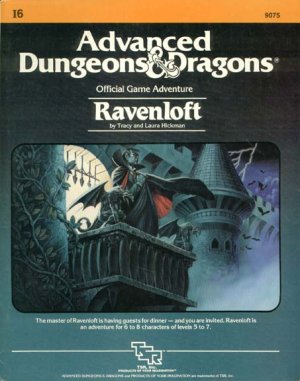
This adventure
Despite being a notoriously tpk-prone adventure, Ravenloft was popular enough to get a sequel adventure and then an official campaign setting. The original Ravenloft setting for AD&D 2E was very-much focused on "weekend in hell" type adventures where adventurers from other settings are randomly dropped into some corner of Ravenloft to have spoooooky adventures and then go back home. Domains came and went all the time, chunks from other popular settings were randomly dropped into the setting (there's Dark Sun realm, a Dragonlance realm, Vecna had his own place, etc.), but there was a lot of cool stuff and the setting developed a devoted fanbase. Especially popular were the Van Richten's Guides series of books, guides to various monster races full of interesting info and useful gaming material, supposedly written by the setting's pre-eminent monsterhunter and Peter Cushing impersonator Rudolph van Richten. When Third Edition came around and the D20 scene exploded, White Wolf started it's own line of D20 books under the brand Sword & Sorcery. And they decided, since they were the "horror guys", to license the Ravenloft setting from Wizards of the Coast. The setting got refocused to center around native adventurers instead of visitors from other settings, got rid of most of the stuff referencing other settings (WW did not have the rights to those) and was overall tighter written. They put out some great books, some garbage one (no line is perfect) and eventually faded out due to not selling enough (the last book written, Van Richten's Guide to the Mists , was never officially published but can be found on the internet). There was no 4E update of the setting, thought there was a boardgame using modified 4E rules (Expedition to Castle Ravenloft). The Shadowfell was also heavily inspired by Ravenloft. I think this was a missed opportunity, seeing how good 4E Dark Sun was: it's decision to keep most of the setting stuff to cosmetic rule changes instead of huge changes to the rules that randomly screws over players would have fit with a more Castlevania approach to Ravenloft. Anyway. Now, a new Ravenloft adventure has been announced for 5E, heralding the return in print of the setting after a 10-year absence. I'm going to cover the 3E/White Wolf era of the setting, cause it'S the one I have, but there's a ton of 2E material someone else could go over too.
So after this history lesson, what is Ravenloft? What's the setting like? Well, it's a giant dimensional prison, created by powerful beings known only as "The Dark Powers", purposefully never given a canonic origin or explanation. They created the "Demiplane of Dread" deep within the ethereal realm, kidnapped a bunch of evil motherfuckers, gave them each a country or realm fit with their particular personalities, cursed them (because why not) and then watched what happens. So Ravenloft is a hodge-podge of realms shamelessly ripped off various horror movies/novels, each with their own boss monster. The realms are trapped within magical Mists that do whatever the plot demands of them. That's the (very) short description of course, I'm gonna cover this stuff more in-depth starting with my next post, where I'll start reading the Ravenloft Campaign Setting .
Setting overview
Original SA post
https://www.youtube.com/watch?v=E6fgUsqHNzA
Part 1: Setting overview
This book is organized like a White Wolf book rather than a D&D book, complete with an absolutely useless index. Chapter 1, then, is an introduction to the world of Ravenloft. It opens with an excerpt from the legendary Tome of Strahd where the titular vampire remembers his backstory: he was a brutal warlord who fell in love with the fiancee of his (much younger) brother. He got a complex over his old age, so he made a pact with death, killed his brother on the wedding day and tried to steal the bride. To no one's surprise, it didn't work. She jumped to her death, he became a vampire, his entire castle (Castle Ravenloft! title drop!) was transported into the Mists and now he's cursed forever.
The major inspiration for Ravenloft is the Gothic literary genre, fathered by Horace Walpole, a "dilettante author enraptured with his own romantic vision of the middle ages". His novel The Castle of Otranto set a lot of the rules of the genre. We read a quick overview of the genre:
Early Gothic Tales followed the formula set by Otranto: crumbling castle reflecting the heart of the villain, innocent hero/maiden, ancestral curses, Good vs Evil clashing and the villain eventually losing more due to his own evil and the divine forces than anything the hero(es) actually did.
The Late Gothic Tradition saw authors focus a lot more on the villain, and re-imagines a lot of old creatures into new forms. This is the when Victor Frankenstein and the first vampire novels come in.
The Victorian Revival sees the creation of the "consulting detective" by Edgar Allan Poe, and of course Dracula is written. Heroes return, with people like Van Helsing, Carnacki, John Silence and Solomon Kane fighting the forces of darkness.
And of course the genre still exists to this day: every Dracula and Frankenstein that comes out if a new Gothic tale, following in the footsteps of their predecessors.
After the inspiration comes the Realm of Dread itself. While at first Ravenloft appears to be a normal Low-Magic Setting to most of ti'S inhabitants, in truth it is a constructed world (probably made by one of those asshole Pathfinder wizards from the Murphy thread) that follows it's own set of rules:
- Good and evil alignments cannot be detected: people have to use their own judgments. This doe snot mean that Good and Evil do not exist, however, as innocent characters find themselves subtly protected and truly evil characters are tempted and cursed by the Dark Powers.
- Necromancy is stronger, but much harder to control.
- Divination is unreliable, unless you're a Vistani , Ravenloft's special tribe of gypsies (...yeah
 ).
).
- Travel through the Mists is unreliable and can dump you in strange places, and powerful magic is needed to travel from one Domain to another. Nothing can help you get out of a Closed Domain.
- It's impossible to travel to other Planes except the Near Ethereal.
So, what are Domains? They're the building blocks of Ravenloft, each a special-made prison for an evil being known as a Darklord. Darklords are given great powers, but are also given a personal curse to torment them. They can never escape their Domains, except through death (with one exception, saved by his author throwing a tantrum). They can, however, close the borders of their Domains. Each one does it in a different way, but it's always a spectacular show of supernatural power. As an example, Strahd can close the borders of Barovia (his Domain) by summoning a thick fog of poisonous vapors that no magic can overcome. Domains vary in size and territory: some are huge swaths of land while others are a single mansion or even a small room.
The Mists are the claws of the Dark Powers. The Misty Border surrounds the world, isolating domains and clusters. There are Mistways, passage through the Mists that (usually) lead to specific places, but outside of them any traveler will soon be lost in an infinite gray fog. Only some powerful Clerics and Vistani can safely travel the Mists. They can appear at any place, at any time, snatching people away or dropping them off, with no logic anyone can fathom. People known as Outlanders are sometimes snatched by the Mists from other realms (the way to get a weekend-in-hell adventure in the old days), in fact most Darklords were originally Outlanders.
Speaking of Darklords, few people actually know of their existence. Some rule their Domain openly, while others either work in the shadows or might not have any political power at all. Darklords are not mindless savages, they had to choose tho commit horrible crimes to merit being chosen by the Dark Powers. Darklords can be destroyed, at which point either a new Darklord arises to take over the domain, the domain is absorbed by another one or the domain simply vanishes back into the Mists.
Next time: History
History
Original SA post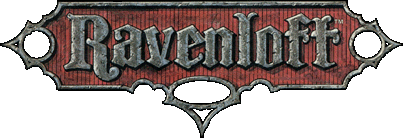
https://www.youtube.com/watch?v=ho9rZjlsyYY
Part 3: History
The history of Ravenloft is a mess, and not just because of the usual writer conflict and cosmic retcons. Every Domain that enters the Mists has it's own history, often conflicting with each other. For convenience's sake, the Barovian Calendar (BC) is used through most of the lands.
Pre-351: The Times Before
Our good friend Strahd is born around 299, becomes a warlord that throws out the Terg (not-Ottomans) out of Barovia (not-Transylvania/Walachia) and then in 31 makes his ill-thought pact to become the first known Darklord.
351-469: A Private Hell
Barovia is all alone the Mists as the original Island of Terror. Few records remain of this era, but it is known that Strahd hunted down Leo Dilisnya, a rival noble who tried to have him assassinated the day of the fateful wedding (trying for his own Red Wedding, I guess). The Dilisnya family remains notorious to this day.
470-546: Outlanders arrive
People start to notice the random adventurers who drop in from other settings. A group of adventurers apparently challenge Castle Ravenloft but is never heard from again (they got TPK'd by the original adventure). The Vistani arrive, and their leader Madam Eva makes a pact with Strahd that endures to this day (she's also apparently still around somehow). Martyn Pelkar, a young orphan, emerges from the woods claiming a luminous being saved him from the ravening beasts that killed his parents. Despite being dismissed as crazy, he ends up founding the Cult of the Morninglord. And finally, a wizard (actually a lich) named Azalin arrives and stays for decades in a tower near Lake Zarovich, trying to find a way out of the Mists working with Strahd.
547-587: the Expanding Stain
New Domains finally start to appear. First is Forlorn, an empty place to the south. Second is Arak to the north, containing actual towns and tales of evil fey. In 579, Mordent appears and with it the first coastline. The circumstances of how exactly Mordent got dragged into the Mists ar eunclear, but are somehow related to Azalin and Strahd being there in their quest to escape. This even isn't really explained, but I'm guessing it's another pre-made adventure. Afterward, the alliance between Azalin and Strahd is broken and the lich goes into the Mists and come out with his own domain: Darkon, a large (the largest) cosmopolitan country. Late in the 6th Century, a blasted wasteland called Bluetspur appears, with the few remaining half mad refugees resettling into Barovia, carrying tales of braing-stealing monsters. Deep in the Mists, a bunch of Island of Terrors show up, but won't matter for a long time.
568-699: Scourge and Expansion
A giant sandstorm, The Sourge of Arak, kills everything in that Domain. A bunch of new Domains show up, creating what is known as "The Core", Ravenloft's biggest cluster of Domains. The Dilisnya family get their own Domain, Borca, and one of them, Yakov Dilisnya, founds the Church of Ezra, one of the most powerful and widespread religions in Ravenloft. It's biggest rival, the Church of the Lawgiver, is established in Nova Vaasa (a Not-Holland domain). Finally, an Outlander named Vlad Drakov shows up, massacres a couples of villages in Darkon with his mercenaries and his promptly kicked out by Azalin.
700-734: Dead Man's campaign
A couple new Domains appear, including one for Vlad Drakov: Falkovnia. He decides he wants to be a warlord and so attempts to conquer Darkon. He fails, sending thousands of his citizens to the slaughter against Azalin's undead hordes. Meanwhile, a Darkonian Doctor, finding his family killed, vows vengeance against the forces of the night: Rudolph van Richten starts his career.
735-740: the Grand Conjunction
741-749: The Land Congeals
Things more or less settle into their current configuration. A few aftershocks of the Grand Conjunction bring in random changes, some Islands of Terrors merge into clusters, stuff like that. There's a bunch of societal changes we'll see more in-depth later. Learning nothing from his previous failures, Azalin starts a new plan to escape, with a new secret society he created harvesting souls from across the realms.
750-755: The Fall of Kings
Azalin completes his artifact powered by souls and attempts to use it to escape. It blows up instead in an event known as The Requiem. Azalin vanishes, his biggest city (Il Aluk) is turned into a city of undead, someone claiming to be Death takes over his kingdom, things are bad. Rudolph van Richten also vanishes, and the Dark Knight Soth is erased from continuity because his creators want him back in Dragonlance. Vlad Drakov thinks now is just the time to start a bloody invasion, but Azalin's hordes of undead show up anyway. His ghost is still around! Adventurers bring back the lich, because the dude might be evil and prone to cosmic fuck-ups but he made the trains run on time, in an epic adventure that was never actually published. Death is trapped in his own Domain, Necropolis.
755: The Present
People speak of a prophecy of a Time of Unparalleled Darkness, but Azalin hasn't fucked it up into being yet.
For those who like random dates referencing tons of stuff that haven't yet been explained, the timeline of events follow:
Timeline posted:
1 The ancestors of Strahd von Zarovich found the Nation of Barovia.
320 The Tergs invade Barovia, conquering the von Zarovich ancestral lands.
321 Strahd von Zarovich leads the armies of Barovia in battle against the Tergs.
347 Strahd drives the last of the Terg warlords from Barovia, claiming the throne as his reward.
351 The wedding of Sergei von Zarovich and Tatyana turns into a massacre through Strahd's murderous rampage and the treachery of Leo Dilisnya. Barovia becomes a domain.
398 Strahd hunts down the traitorous Leo Dilisnya and condemns him to eternal torment.
400 Strahd encounters Tatyana's first reincarnation.
470 The Vistani appear in Ravenloft. Their leader, Madame Eva, forges an alliance with Count Strahd.
475 Earliest records of the Cult of the Morninglord.
528 Powerful heroes assault Castle Ravenloft and are killed.
542 Azalin enters Ravenloft, forming an uneasy alliance with Strahd.
547 Forlorn is drawn into the Mists.
551 The domains of Har'Akir and Paridon appear.
564 Sebua is formed.
575 Araak appears.
579 Mordent enters Ravenloft. Darkon appears.
581 Illithids spawn the domain of Bluetspur.
586 "Bloody Jack" strikes Paridon for the first time.
588 Keening appears. All surface life in Arak is scoured away.
590 Pharazia is formed.
593 Gundarak is formed.
600 Vechor appears.
603 Invidia takes shape under the rule of Bakholis.
607 Sanguinia is formed.
611 Shadowborn Manor enters Ravenloft.
613 Kartakass appears.
615 Nidala is formed.
620 Timor appears.
625 Valachan takes shape.
630 The Sea of Sorrows appears.
635 Souragne is formed. Graben appears.
646 Avonleigh appears in the Phantasmal Forest.
650 The Faith of the Overseer is founded in Darkon.
658 The Wildlands takes shape.
666 Yakov Dilisnya scribes the First Book of Ezra
670 Sri Raji is formed.
682 Nova Vaasa appears.
683 Lamordia is formed.
684 Borca appears.
688 The Crimson Death, a lethal plague, spreads across Darkon.
689 Vlad Drakov enters Ravenloft in Darkon.
690 Falkovnia appears.
691 Tepest takes shape,
694 Richemulot appears.
698 Markovia is formed. Camille Boritsi poisons most of her family.
699 Felix Wachter pens the Second Book of Ezra.
700 Drakov invades Darkon and is repelled.
702 G'Henna appears.
704 Drakov invades Darkon again and is repelled.
706 Dr. Rudolph van Richten vows to battle the forces of evil.
707 Dementlieu appears.
708 Arkandale appears.
709 Joan Secousse pens the Third Book of Ezra.
711 Camille Boritsi is murdered; her daughter Ivana inherits control of Borca. Drakov invades Darkon a third time and is repelled.
713 A shadowy crime lord known only as "the Brain" surfaces in Port-a-Lucine.
714 Hazlan takes shape.
715 Dorvinia appears.
720 Sithicus joins the Core.
722 Drakov invades Darkon once more and is repelled.
728 Saragoss is formed.
729 Othmar Bolshnik assumes the title of Prince of Nova Vaasa. Bakholis is killed by one of his captives, Gabrielle Aderre. A peasant uprising topples his regime.
730 Verbrek takes shape.
731 Vorostokov is formed.
734 Prince Othmar refuses to relinquish his title.
735 The Vistani seer Hyskosa records his Dire Prophecy predicting the Grand Conjunction. Van Richten publishes the first of his texts, the Guide to Vampires.
736 The first verse of Hyskosa's Hexad comes to pass. Duke Gundar, the lord of Gundarak, falls victim to clever heroes and a traitorous servant.
737 The second verse of Hyskosa's Hexad comes to pass.
738 Odiare enters Ravenloft. The third verse of Hyskosa's Hexad comes to pass.
739 The fourth verse of Hyskosa's Hexad comes to pass.
740 The Grand Conjunction rocks the Land of Mists to its foundations, reshaping the domains.
740 Rokushima Taiyoo appears. Saragoss, Sri Raji, and the Wildlands join together to form the Verdurous Lands. Tepestanis organize an inquisition against the fey in response to the formation of the Shadow Rift.
741 Hazlik builds the village of Ramulai to house a school of wizardry. Gennifer Weathermay Foxgrove is mauled by a wolf. Her uncle George shoulders the blame and leaves Mordent.
742 Dr. van Richten publishes the Guide to the Vistani and retires. "Bloody Jack" resurfaces in Paridon for his thirteenth killing spree.
743 The popular bard Harkon Lukas is elected Meistersinger of Skald. Thought destroyed in the Grand Conjunction, Markovia is rediscovered in the Sea of Sorrows.
744 Paridon and Timor merge to form the Zherisia cluster.
745 The demon Malistroi attempts to conquer G'Henna with a fiendish army.
746 Har'Akir, Pharazia, and Sebua join together to form the Amber Wastes cluster.
747 Malocchio Aderre, born to Gabrielle Aderre and a mysterious father, is revealed to be a Dukkar and seizes control of Invidia. Avonleigh,Nidala, and Shadowborn Manor form the Shadowlands cluster.
748 A Lamordian colony on Markovia vanishes without a trace.
749 The Grim Harvest begins as Azalin sends the Ebon Fold into surrounding lands to collect souls for a massive magical experiment. Sanguinia joins with Vorostokov to form the Frozen Reaches cluster.
750 Dr. Rudolph van Richten vanishes. Gennifer and Laurie Weathermay-Foxgrove vow to continue his work. A massive burst of negative energy now known as the Requiem transforms II Aluk into a city of the undead. Azalin is thought destroyed. The Mists reveal the Nocturnal Sea.
751 Teodorus Raines pens the Fourth Book of Ezra. Drakov invades Darkon once again, but the dead still rise to repel his forces. A prince of the shadow fey attempts to reopen a portal to the Plane of Shadow, nearly freeing a monstrous entity of immense power.
752 Azrael usurps control of Sithicus after his former master disappears in the Hour of Screaming Shadows.
753 The Weathermay-Foxgrove sisters print new editions of the Van Richten Guides. The former servants of Azalin begin to receive visions instructing them to aid in his return.
754 Gregor Zolnik kills his wife and mother in a mad rage. His sisters disappear.
755 Heroes restore Azalin to power, foiling a traitorous attempt to enslave his spirit. "Bloody Jack" expected to strike Paridon again.
Next: Geography!
Geography
Original SA post
https://www.youtube.com/watch?v=yNSLaYJboPE
Part 3: Geography
Thanks to the nature of the Mists, it's impossible to get an accurate idea of Ravenloft's size. in fact, none of the maps included in the game have a scale. The biggest continent is commonly know as "The Core", but even then there are a theoretically limitless number of Domains out there in the Mists. Still, the known territory is smaller than most other campaign settings, some might call it claustrophobic.
The Core is the focus of most of the setting, and is the oldest and largest cluster. It seems to be at the heart of the Realm of Dread, with Barovia at it's center. In the North, the continent is dominated by Darkon, a large country where nonhumans are surprisingly frequent and magic is tolerated. Elsewhere, nonhumans are rarer and feared, much like magic. Two of Darkon's neighbor, Falkovnia and Tepest, are particularly hostile to nonhumans, with one treating them as slaves and the other targeting them in their Inquisition against the fey. A large bottomless crevice, known only as the Shadow Rift, separates the Core into two. In the Northwest, shipping, free trade and military alliances have led to something of an age of enlightenment, with high cultural and scientific levels. In the south, things are still quite rustic, with large forests, isolated villages, superstitious peasants and monsters stalking the night. Sithicus is the only major nonhuman realm in the Core, as it is predominantly elvish (it's the Dragonlance Domain). In the Southwest, byzantine politics and oppression of the lower classes abounds in Nova Vaasa and Hazlan. Finally, the Sea of Sorrows is filled with storms and hard to navigate, leading to much fewer ships strolling it's seas.
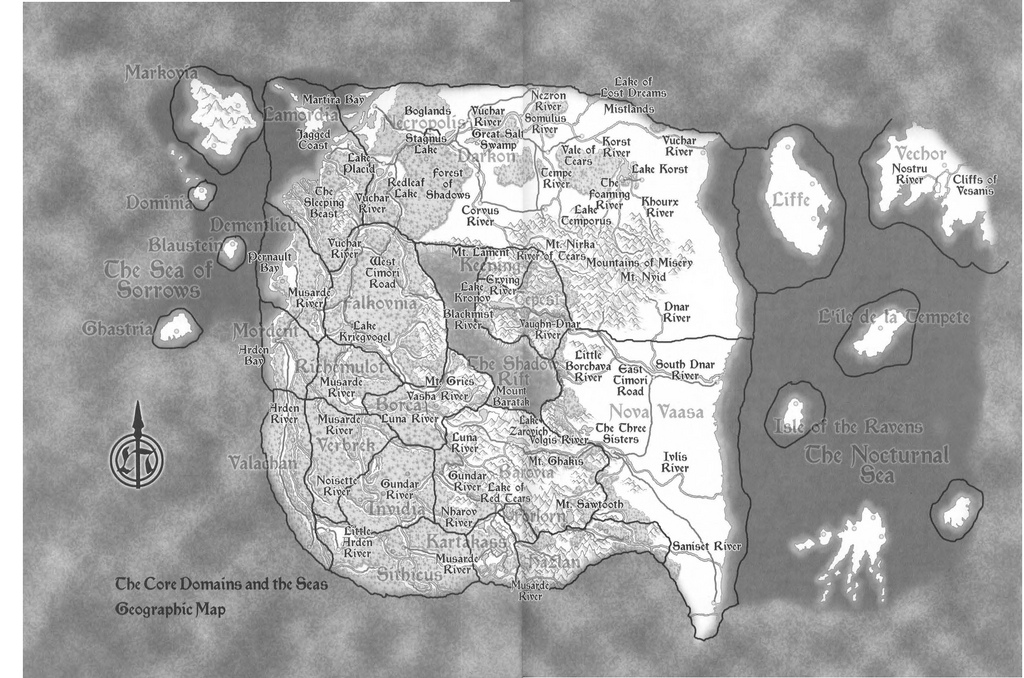
There are a few notables Clusters outside of the Core. The Amber Wastes are a harsh desert land full of empty tombs, sandworms and the like. The Frozen Reaches are large land of perpetual winter. The Shadowlands are slowly encroached by a phantasmal forest. The Verdurous Lands contain an immense jungle and the equally dangerous Sargasso sea. Zherisia is made up of a large city and it's seemingly infinite underworld of tunnels and sewers.
There are also Islands of Terrors , single Domains isolated in the Mists. Bluestpur is a scorched landscape where nothing humans can survive and only monsters dwell. G'Henna is an arid land where the population is slowly starved to death by the cult of an evil god. Odiare is a small city where only children live. Rokushima Taiyoo is a beautiful archipelago being torn apart by four brothers fighting for control of the land. Souragne is a swampland where the dead are forced to till the fields by the Lord of the Dead.
Cultural Levels is how Ravenloft deals with different Domains having different technological advancements. CL determines what is available to buy in these realms, as well as giving and idea of what society is like. It goes from 0 to 9. CL 0 is Savage , pure untamed wilderness. CL 1 is Stone Age , nomadic and semi-nomadic tribes or hunter-gatherers struggling to survive. Stone weapons are much more fragile and have a -1 penalty to hit and damage. CL 2 is Bronze Age , this is the beginning of society, with agriculture and early writing and giant stone monuments. Rulers are often clerics, sorcerers are the first spellcasters and the first magic items start to appear. Bronze Age weapons are more fragile (though no as much as Stone Age weapons) and take a -1 penalty to damage. CL 3 is Iron Age , with the discovery of more advanced metal-working, aqueducts, etc. CL 4 is Classical , with most advances being in the realms of mathematics and medicine. CL 5 is Dark Age , based on the (now outdated) view of how things were after the fall of the Roman Empire. Still advance sin agriculture continue, as well as warfare (crossbows, etc.) CL 6 is Early Medieval , with the first merchant guilds and Gothic architecture. CL 7 is Late Medieval , and is mentioned to be the default setting of 3E D&D. CL 8 is Chivalric , with the advent of the first awkward Gunpowder weapons. Finally, CL 9 is Renaissance , with more advanced firearms and the printing press and other scientific discoveries. Armor and large unwieldy weapons become less popular.
Then we close Chapter 1 with a lexicon:
Lexicon posted:
ancient dead : Also called "ancients"; a broader term for the undead creatures often called mummies.
bloodline : A chain of lycanthropic infection stemming from a single natural lycanthrope.
caliban : A human warped in the womb by unnatural magic.
cleric domai n: A clarification to the term "domain" from the Player's Handbook to avoid confusion with Ravenloft's domains.
cluster : A patchwork collection of two or more domains in a single Mist-bound region.
Core, the : The largest and oldest cluster in Ravenloft, loosely resembling a microcosmic, Gothic Europe.
Cultural Level (CL) : A rough measurement of a community's technological level. Affects equipment and skill availability.
darklord : The evil master — and ultimate prisoner — of a domain. A descriptive term, it is not used by characters in the setting.
Dark Powers : The faceless, godlike forces that shape the Realm of Dread. A descriptive term; their true nature and intentions remain a mystery.
domain : A pocket dimension created to imprison and torment a singular evil creature, its darklord. Domains often resemble Material Plane locations and may contain sizeable populations.
domain border : Darklords can close the borders of their domain, preventing escape. No mortal magic can overcome a closed domain border.
Dukkar : A legendary foe of the Vistani, said to be a male Vistana gifted with the Sight and fated to bring destruction to his people.
ethereal resonance : The landscape of the Near Ethereal, shaped by the echoes of emotionally charged events.
Fear save : A Will save vs. fear effects.fiend: Any powerful, evil outsider.
giogoto : The Vistani term for half-Vistani. Both singular and plural.
giorgio : The Vistani term for non-Vistani. Both singular and plural.
Grand Conjunction, the : An arcane term for a cataclysmic event in 740 that nearly destroyed and permanently reshaped the Land of Mists. It was foreseen by the Vistani seer Hyskosa. Within the setting this event is more commonly known as the Great Upheaval.
Grim Harvest, the : A murderous conspiracy forged to collect souls to power a grand and terrible magical experiment. Lasting from 748-750, it culminated in the Requiem.
Horror save : A Will save vs. horror effects.
Hour of Screaming Shadows, the : A terrifying night in the autumn of 752 when a mass of living shadows smashed into Nedragaard Keep in Sithicus, apparently killing the black knight who ruled it.
Innocence : The total absence of evil in a mortal spirit. Evil creatures are both drawn to and threatened by Innocence, like moths to a flame.
insane : Any creature suffering from a madness effect.
Island of Terror : A single domain, surrounded on all sides by the Mists.
Madness save : A Will save vs. madness effects.
Mists, the : As the Misty Border, these banks of unnatural fog separate clusters and Islands of Terror. The Mists can also appear at any place or time within Ravenloft. They are presumed to be the agents of the Dark Powers and can twist time and space.
Mistway : A relatively reliable travel route through the Mists.
Outcast Rating (OR ): A modifier to social skills, reflecting the xenophobia of Ravenloft's denizens.
outlander : Anyone who comes from "beyond the Mists," perhaps even from another world.
Near Ethereal, the : The borderland between Ravenloft and the Ethereal Plane.
powers check : A percentile roll to determine whether the Dark Powers respond to evil acts.
rank : A measure of the power of ghosts, ethereal resonance, and the ancient dead. Not to be confused with skill ranks.
Ravenloft : A descriptive term for the setting. To characters within the Land of Mists, Ravenloft is just a castle in Barovia.
recovery check : A Will save made to recover from horror or madness effects. Failing the check incurs no further penalties.
Requiem, the : A catastrophic event in 750 in which an expanding wave of negative energy slew Il Aluk. Darkon's king was thought killed in the blast but has recently reemerged.
Scourge of Arak : A massive sandstorm in 588 that wiped out all surface life in the region now known as the Mountains of Misery in Darkon.
sinkhole of evil : A spiritually unclean area that applies penalties to Will saves and turning attempts. The effect of powerful ethereal resonance spawned by acts of evil.
Vistani : A mysterious, gypsylike people who roam the Land of Mists. They are feared and respected for their evil eye and power over the Mists. Vistani is plural; the singular form is Vistana.
Next, we'll start Chapter 2 and delve right into all the rules change they made.
Races
Original SA post
https://www.youtube.com/watch?v=_yfwKWNDpSY
Part 4: Races
Chapter 2 is all about the Player rules, covering the usual D&D fantasy races, classes, etc. First up are the races, with how the old ones are in Ravenlfot and a couple new ones. Each races gets an Homeland, Recommended Feats and a base OR. What's OR? It stands for Outcast Rating, a base penalty to social rolls because everyone in Ravenloft is somewhat xenophobic (you never know when the stranger visiting you is actually a monstrous doppelganger there to steal your soul).
The base languages are also different: Common doesn't exist in Ravenloft. Instead you get a dozen pastiche of real-world languages, and if their French (my first language, with English being the only other one I know) they're all L5R level of terrible. The more widespread ones are Balok (the not-Romanian of Barovia), Darkonese (the not-Latin of Darkon), Mordentish (not-french, despite Mordent being not-England), Vaasi (not-Swedish from Nova Vaasa) and Draconis (the language of magic, with almost no dragons actually living in Ravenloft). Strangely enough, Mordentish has both a High-version for nobles and a Low-version for commoners, with Low Mordentish kinda sounding flemish, so there's some Belgium influence there too.
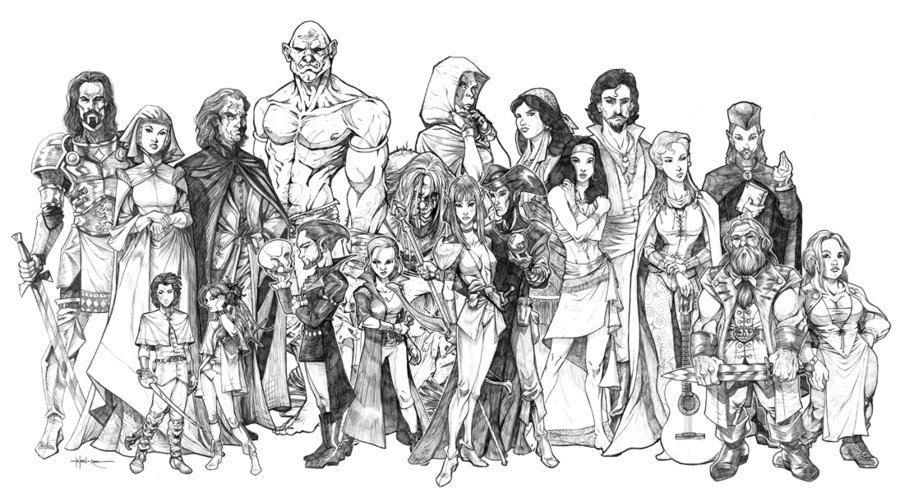
Humans are their usual generic self. Their prevalence in Ravenloft might be due to their great capacity for Good or Evil, recognized by the Dark Powers. Their Homeland can be anywhere with settlements, their Recommended Feats will vary by Domains and they have a base OR of Zero.
Non-humans are a lot rarer than humans, and face mroe discrimination as a result, with many thinking them related to the Fey or vectors of Lycanthropy or other superstitions. Some (human) scholars have theorized that non-humans are facets of humanity, placed there by gods to reflect against humanity's light. Most non-humans scoff at this, as they know their cultural traits are not iron-clad and they possess free will too.
Calibans
Replacing the Half-Orcs (Ravenloft has neither Orcs nor Dragons), Calibans are humans who were exposed to dangeorus magic or cursed before their birth, ending up deformed and ugly. The inspiration here is clearly Caliban from Shakespeare's The Tempest , son of the witch Sycorax. While all Calibans are different, they do tend to be big and brutish. They have the same stats as the Half-Orcs from the Player's Handbook.
Homeland: Calibans can come from anywher,e although they are more frequent in Domains with more magic, such as Darkon, Hazlan and Tepest.
Recommended Feats: Alertness, Endurance, Great Fortitude, Jaded, Lunatic, Run, Skill Focus (Intimidate, Wilderness Lore), Voice of Wrath.
Base OR: 5, quite the penalty.
Dwarves
Dwarves are pretty much how you expect them to be, a stout hard-working race dedicated to forge and family and feeling a deep kinship with the earth. Some humans have distorted this, believing that dwarves are actually elemental spirits. Many human folktales speak of dwarves who require a diet of gold and gems or who turn to stone if touched by sunlight.
Homelands: The center of dwarven culture is the town of Tempe Falls in Darkon, though nearby Corvia also hosts a sizeable dwarven population. Smaller dwarven communities have also spread south along the Balinoks and to other mountainous regions, such as the Sleeping Beast of Lamordia. In recent years, dwarven explorers have also been making inroads into the forsaken region of the Mountains of Misery once known as Arak. There they have been laboring to reopen the abandoned mines and a long-neglected trade route that once connected Tempe Falls to Liara in Nova Vaasa.
Recommended Feats: Back to the Wall, Courage, Craft Magic Arms and Armor, Endurance, Great Fortitude, Iron Will, Jaded, Skill Focus (Craft [armorsmithing, blacksmithing, stonemasonry, weaponsmithing]).
Base OR: 3, not as bad as the Caliban.
Elves
There are two distinct "tribe" of Elves in Ravenloft: the Elves of Darkon who tend to have dark hair and the Elves of Sithicus who all have silver hair and amber eyes. Elves are close to nature and live long lives, to the point where in Domains wher ethey are less frequent they are thought to be either nature spirits taking human form or Fey creatures. More than one elf has had their "immortality" tested by the Inquisitors of Tepest.
Homelands: There are three major Elvish cities in Darkon (Neblus, Nevuchar Springs and Sidnar) and Elves are the only non-humans races to have their own Domain, Sithicus. Some elves move in to human Domains and there are tales of Elves serving as advisers to entire Human Dynasties.
Recommended Feats: Alertness, Ethereal Empathy, Scribe Scroll, Skill Focus (Wilderness Lore), Track, any metamagic or item creation feat.
Base OR: 3, same as the Dwarves.
Gnomes
Humans are less afraid of the tiny Gnomes, but are still wary of their eccentric personality. Not quite Tinker Gnomes, they still are a curious race fond of puzzles and mechanisms. They also apparently have a pretty macabre sense of humor.
Homelands: The largest Gnome settlement is the town of Mayvin in Darkon. Due to their specific skillset, most Domains have a small Gnome community of almost a 100, with Nova Vaasa having the largest due to the popularity of having a Gnome court jester.
Recommended Feats: Alertness, Craft Wand, Craft Wondrous Item, Dodge, Open Mind, Scribe Scroll, Skill Focus (Bluff, Craft [alchemy, clockmaking, gunsmithing, locksmithing]).
Base OR: 2.
Half-Elves (fey-born)
Half-Elves are rare, and outsiders pretty much everywhere. Some consider them cursed by their heritage, outliving their human friends but dying of old age before their elvish ones. Many channel their feelings into the arts, where being an outsider is pretty normal. A few even reject their given names, adopting dramatic titles like the Wind Haunter or the Deathseeker (Player Characters if I ever heard of one).
Homelands: Half-elves don't have an actual community, but are more frequent in areas neighboring Elf settlements (Sithicus or Darkon).
Recommended Feats: Alertness, Iron Will, Jaded, Redhead, Run, Track, Skill Focus (Diplomacy, Disguise, Perform).
Base OR: Almost, but not-quite, human.
Halflings
Halflings often look like human children, and as such are feared by no one and welcome in most places. Some human bards claim that halflings were created when a powerful hag tried to purify a human as an experiment, driving all the evil from his body. The experiment was a success, but the victim was reduced to half his former size, the "evil half vanishing to none-knows-where. Halflings pay this legend very little mind.
Homelands: Most halflings are nomadic, wandering from Domain to Domain in clans. They stay a few years before moving on, to experience all it has to offer before moving on. There are two permanent halfling communities, both in Darkon: the Haflings of Rivalis raise goats, produce cheese and take pride in their flower gardens, while the inhabitants of Delagia mostly subsist through fishing. For those who hate Kenders:
quote:
Tales are told of a village of halflings hidden somewhere in the forests of Sithicus. These halflings were hideously tortured by the black knight who previously ruled that land, however. They are now said to be insane, feral creatures.
Base OR: 1, like Half-Elves.
New "Race": Half-Vistani

Yeah, apparently being half magic Gypsie is a thing. They're the result of a "torrid love affair" between a Vistani and a non-Vistani, and can be raise dby either parent but will never really fit in They've got different racial traits than other humans, despite being completely human.
They get +2 to Wisdom and -2 to Charisma.
They're Medium-sized.
Their Base Speed is 30 feet.
They have a +2 to Wilderness Lore, +4 if it's to start a fire (what the shit what kind of bad bonus is that?)
Moon Madness: A giogoto suffers from the lunatio during the full moon each month, her mind clouded by restlessness and anxiety. She cannot prepare spells or heal naturally during this period. On each of the three nights of the full moon, she must succeed at a Will save (DC 15) or run wild under the night sky. (What the fuck!!?)
Base OR: 2, but can be lowered by a successful Disguise Check (holy shit, humans with Gypsy blood have bigger penalties than Half-Elves and Halflings)
Base Languages are like any other humans, except they can learn the Vistnai patterna .
Recommended Feats: Alertness, Ethereal Empathy, Lunatic, Track, Voice of Wrath.
Tribal Heritage: The Vistani tribe of the parent determines favored class and an additional bonus.
quote:
Canjar : +2 racial bonus on Spellcraft checks. This bonus rises to +4 when attempting to learn new spells. Favored Class: Wizard.
Corvara : +2 racial bonus on Open Lock and Sense Motive checks. Favored Class: Rogue.
Equaar : +2 racial bonus on Handle Animal and Ride checks. Favored Class: Ranger.
Kamii : +2 racial bonus on any metal-based Craft checks (e.g., blacksmithing) With a successful Appraise check, Kamii can identify metals and determine where any metal item originated. Favored Class: Rogue.
Naiat : +2 racial bonus on Perform checks. Naiat have a base Outcast Rating of 0. Favored Class: Bard.
Vatmska : +2 racial bonus on Heal and Profession (herbalism) checks. Favored Class: Cleric.
Zarovan : Racial bonus of (1d10-1d4) to initiative. Roll at the start of each encounter. Favored Class: Sorcerer.

Wow. This is way worse than I remember. Setting aside the racism of making Half-Gypsy a fucking race option, it's a terrible one mechanically! None of those tiny bonuses are worth giving up the bonus feat and skill points of being human! Even the one that gives a bonus to Initiative is super random and can actually give you a negative one!
Erm, anyway. Next time, we'll cover the changes made to the Character Classes.
Classes
Original SA postI approve of Halfling BB Hood.

https://www.youtube.com/watch?v=_jBLyIQvNf0
I realize I forgot to cover Chapter 2's intro fiction, so I'll do it here. This time, it's a letter from Gennifer Weathermay-Foxgrove to her Uncle George, informing him of the work she and her twin Laurie have been doing trying to continue Doctor van Richten's work after his mysterious disappearance. This introduces some of my favorite NPCs, and we'll get the whole story about Rudolph Van Richten and the Weathermay family eventually, but the gist of it is that Van Richten and George Weathermay are accomplished monster hunters and that the Weathermay-Foxgrove tins idolizes them and want to follow in their footsteps. The first thing they did was start reprinting Van Richten's old Guides and started working on some new ones. See, the reason Van Richten is feared among monsters and revered among heroes isn't that he's an amazing monster hunter (though he was certainly a good one), but that he published and spread books full of monsters weaknesses and powers, giving the world at large useful tools to fight back. I love that concept.
Anyway, onward to
Part 5: Classes
Barbarian
Barbarians mostly come from small communities or tribes, such as the frozen land of Vorostokov or the tiny hamlets of Verbrek. They usually serve as warrior, hunters and protectors. They value strength, eschew "dirty tricks" and are usually very superstitious (the Voros of Vorostokov are mentioned as believing all writing inherently contain evil magics). The people from more "enlightened" regions tend to view them with disdain at best.
Altered Class Features:
They only they get is a +4 bonus against Fear, Horror and Madness checks when in Rage, and only when Raging. Woo.
Bard
Bards tend to come from more civilized lands, wher etravel is easier and audience are more receptive to tales of other lands (true or not). Most bards aspire to study at the famed bardic colleges of Kartakass. For a bard, little in life yields more prestige than to be admitted to the Harmonic Hall or to perform in Harmonia's amphitheater. Kartakass, as you may guess, is Bardland.
Altered Class Features
:
Some spell are changed (expect all spellcasting classes to get that one)
They get a +10 to Bardic knowledge DC when in an unfamiliar domain. This penalty is lowered by -1 for each month they spend there. Starting characters get number of Domains equal to their level with no penalty (so lvl 1 Bard get their home Domain and nothing else). You don't get to pick one more Domain when you level up.
There's an optional rule for Evil Bards to be able to cause Fear checks in their audience if they succeed by more than 10 on their Perform check.
Cleric
There's plenty of new religions in Ravenloft, as well as slightly different takes on old ones (The Morninglord is a slightly different take on Lathander from Forgotten Realms, the Lawgiver is Bane, etc.), but they're covered in the Religion section of the chapter. Clerics are really important and are usually well received.
Altered Classe Features:
Some spells are changed.
If they want, evil clerics of nonevil deities can opt to channel spell energy into cure spells in the same manner as neutral clerics of neutral gods. This choice still determines whether the cleric turns or commands undead.
All undead creatures in Ravenloft have +1 Turning Resistance (if they had none, they now have +1). This bonus stacks with that of Sinkhole of Evils (explained way later in the book).
Undead Darklords get either +1 or their Wisdom modifier as a bonus to their Turning Resistance, whichever is higher.
Also, normally undead are instantly destroyed when turned by a cleric with double or more their HD in levels, but in Ravenloft this occurs only when they cannot escape (either restrained or cornered).
Druid
According to tradition, the first Druids in Ravenloft arrived with the Domain of Forlorn, but have since spread throughout. Druids are still all about balance and preserving nature, except since Ravenloft is so out of balance you'll find a lot of Druids fighting to destroy these "sinkhole of evil" and restore balance.
Altered Class Features
They forget to put the "some Spells are different" thing here, but trust me, some spells will have changed.
Animal companions can be hijacked by Darklords (joy!), but they can never be made to attack their Master or his companions. When ordered to, they'll usually run away from the conflicting loyalties, returning only when leaving the Domain.
Woodland Stride can't be used to cross closed Domain borders.
Trackless Step still leaves a smell trail.
Venom Immunity does not protect against closed Domain borders.
Fighters
Fighters are fighty dudes from wherever. They try to make them look cool, but it's the Fighter.
Altered Class Features
:
Fighters GET NOTHING!!!
Ok, ok, not quite true. They get a few new Feats added to their list: Back to the Wall, Courage, Dead Man Walking, and Jaded.
Monk
There are few Monk traditions in Ravenloft. They exist in the wonderful land of NotJapan (Rokushima Taiyoo) and in NotIndia (Sri raji, where they are called
fakirs
). The Monk tradition also exists in Paridon, where it merged with occult lodges to create the "theological philosophy" they call the Divinity of Mankind. Those sound kind of cool, too bad we never got a Paridon book! (All you get is an old 2E adventure and a fanmade pdf)
Altered Class Features:
Diamond Body and Abundant Step can't help cross closed Domain borders.
Empty Body only allows access to the Near Ethereal Realm.
Perfect Self is weird, so I'm just going to re-transcript: If the monk has a good or evil moral alignment, she develops a reality wrinkle with an initial radius of 1,000 feet per level. If the monk fails any power checks, consider them failed power rituals; each failed check adds 1d4 corruption points to the monk's total and halves the wrinkle's radius. See "Fiends" in chapter 5 for more details.
So basically, Monks eventually get so Enlightened that reality warps around them.
Paladin
Paladins in Ravenloft are a BIG FUCKING DEAL. They're not just some magic knights, they're the Chosen Ones, destined to face the creatures of Evil with divine might of justice. They appear to not fit within the world created by the Dark Powers, and in some ways the deck seems stacked against them.
Altered Class Features:
Detect Evil works like Detect Chaos instead, thanks to the Dark Powers clouding powers that detect moral alignments, but there are two exceptions: Paladins can detect Innocents (to be explained later) and they can detect Evil Outsiders.
Divine Grace is slightly stronger, adding the bonus to any social roll to influence a Good NPC (effectively adding Charisma twice), but becomes a penalty when interacting with Evil NPCs.
Divine Health doe snot protect against Curses or Darklords.
Aura of Courage does not protect against Fear checks, only Magical Fear effects.
Turn Undead works like with Clerics.
Did you know that some spells are changed!?
Paladin's mounts are replaced with a Dread Companion.
Paladin can be detected by Darklords who succeed at a Scry check (DC 25 - Paladin level), as they disrupt the natural order of things in Ravenloft.
What's a Dread Companion? It's a template automatically added to any Paladin mount or Arcane Familiar summoned in Ravenloft (but not animal companions): they become Evil Magical Beasts (so if a Lawful Good Paladin summoned a mount, it would instead be Lawful Evil) but still fiercely loyal to their Masters. So look forward to your horse brutally murdering that asshole tax collector when your Paladin's back is turned, I guess.
Ranger
Not much to say: like Barbarians and Druids, they mostly stay in the wilderness. They're respected as guarding the frontiers between settlements and the dark places.
Altered Class Feaures:
Just spells.
Rogue
Rogue are expanded a bit: they're not just thieves and tricksters, but investigators and explorers. Rudolph Van Richten back in 2E was, IIRC, a 9th-level Rogue.
Altered Class Features:
They really do get nothing.
Sorcerer
Sorcerers are freaks who are naturally gifted at magic. People fear them, thinking that they're either Fey Changelings or that they gained their powers through a pact with a Fiend or something equally superstitious. Vistani women are often sorcerers, with mostly divination and enchantment spells. Vistani men sorcerers are killed as soon as they exhibit powers, lest they become a
Dukkar
, a cursed being who will cause great harm (there are two major Dukkar characters in the setting, one of them being the Seer Hyskosa).
Altered Class Features:
Some spells are different.
A Familiar is a Dread Companion.
Wizard
There are a few domains where Wizards are accepted and trained (Darkon and Hazlan are major ones), but most other places fear Wizards because they're assholes who have a tendency to go crazy with their own powers and become supervillains. So not that different from normal D&D Wizards (insert that "No notions of right and wrong" comic here).
Altered Class Features:
Some spells are different.
A Familiar is a Dread Companion.
(I copy-pasted from Sorcerer, can you tell?)
Next time, we'll go over Skills and Feats.
Skills and Feats
Original SA post
https://www.youtube.com/watch?v=D1PH_Y8Xn4g
Part 6: Skills and Feats
A few skills work differently in Ravenloft, and we get an entire new skill to boot!
Alchemy can be used to make gunpowder (DC 15) for 5 silver pieces and ounce. You can make a huge batch at once (DC 20), but if you fail your check by more than 5 it explodes.
Animal Empathy: When under the influence of a Darklord, the Darklord's Charisma bonus is added to the DC.
Bluff can be used for Fortune-Telling or Seduction, as well as it's usual uses from the base game. They're basically just different sorts of lies.
Craft gets two new specializations: clockmaking and gunsmithing. If you have 5 ranks or more of Craft: Clockmaking, you get a +2 bonus when dealing with wheel-lock firearms.
Knowledge gets three new fields of study: Monster Lore (each type of monster is a specific subskill), Ravenloft (a specialized for of Knowledge: Planes dedicated to Ravenloft, only held by Darklords and a few scholars) and Lore skills, which are basically folklore.
The new skill is Hypnosis , it uses Charisma and is trained only. It's a weaker version of the hypnosis spell.
And that's it for Skills Onward to Feats!
Back to the Wall
When cornered, you fight harder! It requires a BAB of +2, and gives a +2 to AC and Attack Rolls when at a quarter of less of Max HP.
Cold One
You're cold. Can only be taken when you've had at least one level drained from you. Undead tend to think you're one of them (intelligent ones can make a DC 13 Wisdom roll to notice) and you die slower when under 0 hp, but heal naturally slower.
Courage
A straight +4 bonus to Fear saves. No pre-requisites.
Dead man Walking
You accept that you're doomed and are living on borrowed time. You need to have failed at least one Horror check or been reduced to -1 HP to take this feat. After the first Fear or Horror save, you receive a +2 bonus to all saves and skill checks for the rest of the encounter. You just go "Yep, time to die."
Ethereal Empathy
You can sense the emotions imbued within an ethereal resonance (stuff like ghosts or the sinkholes of evil that keep getting mentionned). You need to have at least 13 Wisdom to take it. The stronger the emotion, the easer the check from DC 20 down to 0 depending on the case).
Ghostsight
You can see ghosts and other creatures that live on the Ethereal plane. They can see you too, though. Only characters that have been under 0 HP or have died and been brought back can take this.
Haunted
The ghost of someone close to you is following you to help (mostly through spotting stuff you missed). The pre-requisite is, obviously enoguh, that someone close to your character has died.
Jaded
Same as Courage, but for Horror saves.
Lunatic
You are affected by the moon, kinda like the Vistani (
 ). Only Chaotic characters can take this. It's a variable bonus to stuff (+1 when the moon is gibbous, +2 during the Full moon, -2 during the New Moon), inverted for Will saves. Seems pointless to me.
). Only Chaotic characters can take this. It's a variable bonus to stuff (+1 when the moon is gibbous, +2 during the Full moon, -2 during the New Moon), inverted for Will saves. Seems pointless to me.
Open Mind
Same as Jaded and Courage, but for Madness checks.
Redhead
Folklore says redheads are touched by the fey. Somehow this gives you magic powers. Requires red hair and a Wisdom stat of 11+. Gives you one lvl-1 and two lvl-0 Druid spells. Can only be taken at character creation.
Reincarnated
You have some vague memories of your past life. You have one more class skill (your choice) and gain a +2 bonus to Charisma checks with a specific person in the world (your "soulmate"). Can only be taken at character creation.
Voice of Wrath
You gain a +4 bonus when trying to curse people. Since this is usually when you get unfairly murdered, I fail to see the usefulness.
In fact, a lot of these Feats are extremely situational. Same with Skills.
One last thing, a sidebar addresses the Leadership feat and how it is changed by Ravenloft: the one-step-away restriction on alignments applies only to Ethical (Law/Chaos) Alignment and not to Moral (Good/Evil).
And that's it, a relatively small and boring update. Next, we'll go over Religions, a much better subject!
Religion
Original SA post
https://www.youtube.com/watch?v=iCEDfZgDPS8
Religion (and the rest of Chapter 2)
Religion in Ravenloft doesn't work quite like it does in other Campaign Settings (only Eberron has a similar setup). Instead of one pantheon that objectively exists that directly talks to it's priests and all gods belong to it, you've got a whole bunch of religions that don't really work together or even like each other. In fact, Clerics from other worlds instantly feel a void where the voice of her God used to be, the connection severed instantly. And yet, the powers remain. Ravenloft natives are used to the Gods being remote and inscrutable, and regard it as a matter of common sense. In fact, many religions in Ravenloft have drifted considerably from their original tenets, but still retain their powers. Some theologians aware of these facts have come up with a theory of an "unspoken pacy", with the Gods of the multiverse agreeing not to directly interfere in the affairs of Ravenloft with the Dark Powers agreeing to do the same in return (that is, not interfere with the Gods). Another, more extreme theory holds that the Dark Powers have cut off Ravenloft from the Gods completely, and when someone prays in Ravenloft it is the Dark Powers that hears them. Some madmen and heretics even go so far as to say that many Gods have long since died, or never existed in the first place.
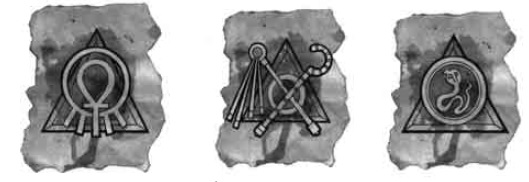
(Please forgive the crappy jpegs)
The Akiri Pantheon
Basically, the Hollywood Egyptian Gods. This religion is mostly popular in the Amber Wastes cluster: in Har'akir the Old Gods are still worshiped openly while in Pharizia (the other Domain of the cluster) the "angelic despot" Diamabel persecutes worshipers, attempting to replace it with worship of himself. The three major gods are the Ra, the sun disc, father and king of the Gods, Osiris, who was killed by his brother and now rules the underworld and Set, god of deceit and the destructive power of nature, who killed his brother Osiris out of jealousy. Clerics of Ra often serve as Viziers and community leaders, clerics of Osiris prepare corpses and "guard the sanctity of death" (hunt undead, I guess?) and clerics of Set often pose a clerics of other deities to subvert the faithful.
Ra is Lawful Good; has the domains of Air, Good, Law and Sun; and his favored weapon is the Falchion.
Osiris is Neutral Good; has the domains of Good, Protection, Repose (explained below) and Water; and his favored weapon is the light flail.
Set is Lawful Evil; has the domains of Death, Evil and trickery; and his favored weapon is the short sword.
The Repose Domain
is a new Cleric Domain in Ravenloft. It's all about helping the dead rest. It's granted by Osiris and the Eternal Order (to follow). The Domain's granted power permits the cleric to grant a resistance against turning into an undead to the dead (a will save using the cleric's will save bonus). The Domain spell list is:
1 Detect Undead . Reveals undead within 60 feet.
2 Gentle Repose . Preserves one corpse.
3 Speak with Dead . Corpse answers one question/two levels.
4 Halt Undead . Immobilizes undead for one round/level.
5 Raise Dead . Restores life to subject who died up to one day/level ago.
6 Antilife Shell . 10-foot field hedges out living creatures.
7 Resurrection . Fully restore dead subject.
8 Control Undead . Undead don't attack you while under your command.
9 Soul Bind . Traps newly dead soul to prevent resurrection.
It feels a lot more like it's meant for NPCs than PCs, especially the granted power.
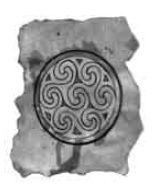
Belenus
In other worlds, Belenus is just another member of a pantheon of Celtic gods. But he's big in
Belenus is Neutral Good; has the domains of Fire, Good and Sun; and his favored weapon is the sickle.
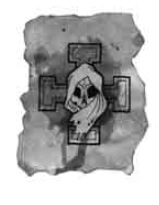
The Eternal Order
A fake religion created by Azalin Rex as a tool of societal control, The Eternal Order believes that their land originally belonged to the Dead and was stolen by the living, banishing the Dead to the Gray Realm. The clerics worship a pantheon of death gods borrowed from other religions. Worship focuses on rituals intended to appease the Dead and delay the Hour of Ascension, when the Dead shall reclaim the land. When the Requiem occurred, the clerics of the Order blamed the population for being too weak in their faith, which had the unintended effect of Darkonians abandoning the Church in drove. The Religion is now dying fast.
The Eternal Order are Neutral Evil; have the domains of Death, Evil, Knowledge and Repose; and their favored weapon is the Scythe.
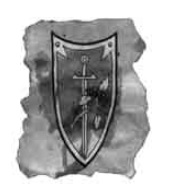
Ezra
The church of Ezra was founded 90 years ago when a descendant of the Dilisnya family claimed that a divine entity, Ezra, our Guardian in the Mists, had given him a revelation. Ezra supposedly was a virtuous mortal woman who, despairing of the evils of the world, forever surrendered her mortality to the Mists to become an eternal guardian of mankind. The original Lawful Neutral sect, centered on Borca, is called the Home Faith and appoints Ezra's clerics, called anchorites, to the task of protecting and healing her faithful. The Lawful Good sect in Mordent also teaches that they must convert as many people as possible for their own good. The Neutral sect in Dementlieu is more mystical, claiming that Ezra abandoned her callous fellow gods to help humanity. The Lawful Evil sect in Nevuchar Springs believes that a Time of Unparalleled Darkness is coming where all the unfaithful will be destroyed. All four sects agree that Ezra cannot protect those who do not believe in her.
Ezra is Lawful Neutral (usually); her domains are Mists, Destruction, Healing, Law and Protection; and her favored weapon is the longsword.
The Mists Domain
is exclusive to Clerics of Ezra, reflecting their patron deity's close relationship with the Mists. The granted power, the SHield of Ezra, has different effects depending on which sect the cleric is from: Lawful good: 25/+5 damage reduction vs. metal weapons, Lawful neutral: 15/+1 damage reduction vs. all physical attacks, Neutral: +10 to all Fortitude and Reflex saves vs. damaging spells and Lawful evil: +10 to all Will saves vs. mind-affecting spells and effects.
1 Obscuring Mist. Fog surrounds you.
2 Fog Cloud . Fog obscures vision.
3 Gaseous Form . Subject becomes insubstantial and can fly slowly.
4 Solid Fog . Blocks vision and slows movement.
5 Mind Fog . Subjects in fog suffer -10 Wis, Will checks.
6 Wind Walk . You and your allies turn vaporous and travel quickly.
7 Teleport without Error . Mists instantly transport you anywhere, with no off-target arrival.
8 Vanish . Mists instantly transport a touched object.
9 Imprisonment . Traps subject within the Mists.
I feel that it's a pretty strong domain overall.
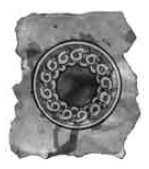
Hala
According to her holy book Tales of the Ages , nine gods created the world and then left intending to leave mortals to do what they will, and only Hala returned, taking pity on them. She gathered together thirteen women and taught them the magic of the Weave, a form of magic that is also called witchcraft. The Church of Hala is secretive and highly mystical. Her clerics, who call themselves Witches, operate a number of hospices throughout Ravenloft, many of them in secret due to how often people fear them.
Hala is Neutral; has the domains Healing, Magic and Plant; and her favored weapon is the Dagger.
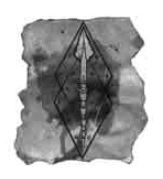
The Lawgiver
Also known as the Iron Tyrant and the Black Lord, his clerics claim the revelation of his true name would strike a mortal dead. This religion is all about blind obedience to authority: the rich and powerful deserve it due to their birth, and the low must obey. It is the state religion of Hazlan and Nova Vaasa. The Lawgiver fell silent during the Grand
Conjunction. His clerics either believe this was a test of their faith or that he was wounded and has now recovered. A few heretics believe the God might be dead, and the church now worships only empty titles.
The Lawgiver is Lawful Evil; has the domains of Death, Evil, Law and War; and his favored weapon is the Whip.
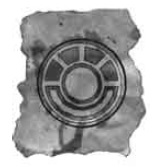
The Morninglord
Founded in the late fifth century by an orphan who claimed he had been saved by the Morninglord, the church portrays it's god as a luminous sylvan humanoid, his face smeared with blood. This strange detail is most often interpreted as saying even the best people have some darkness int hem, and even the most vile have some good that can be reached. Carrying a message of hope, the religion has started to spread among the oppressed Gundarakites of Barovia. No matter how bleak the future may seem, no matter how dark the night, the dawn will come. One of the cult's founders was also a vampire hunter, and it is possible the cult has continued this tradition in secret.
The Morninglord is Chaotic Good; has the domains of Good, Luck, Protection and Sun; and his favored weapon is the Halfspear.
Sidenote: The Morninglord's my favorite. Who doesn't want to smite vampires while screaming "I AM THE MORNING SUN, COME TO VANQUISH THIS HORRIBLE NIGHT!"
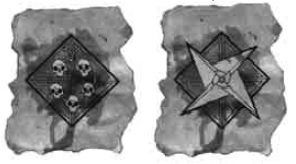
The Rajian Pantheon
The people of Sri Raji worship an extremely huge and complex pantheon of gods that outsiders have difficulty understanding. Their belief centers on an endless cycle of reincarnation that can be escaped only through perfect spiritual understanding and enlightenment. Two gods are of note: Kali, the Dark Mother who destroys and recreates the world and Tvashtri, an enlightened god of industry and invention. The University of Tvashtri is one of the greatest (if remote) in Ravenloft.
Kali is Chaotic Evil; has the domains of Destruction, Evil, Healing and Trickery; her favored weapon is the Sap.
Tvashtri is Chaotic Good; has the domains of Chaos, Knowledge, Magic and Plant; his favored weapon is the Punching Dagger.
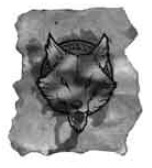
The Wolf God
The Wolf God is worshipped by evil Werewolves, who see all other creatures (including humans) as abominations to be slain or herds to be thinned. Their rites are quite bloody.
The Wolf God is Chaotic Evil; his domains are Animal, Strength and Trickery; and he has no favored weapons (gotta use our claws).
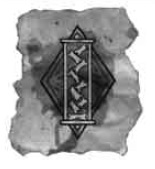
Zhakata
Zhakata is not worshiped: he is appeased. Zhakata exists in two aspects: the Devourer and the Provider. G'Hena has known only the Devourer. The Devourer is a god of cruel austerity, all crops are donated to the priests who will take the god's share and then dole out the remaining in meagre portions to the starving peasants. Buying or selling food is a crime, obesity is sacrilege. Supposedly, one day Zhakata will be appeased and become the Provider, bringing an era of plenty. Generations have starved to death waiting for that day.
Zhakata is Lawful Evil; has the domains of Destruction, Earth, Fire and Protection; and his favored weapon is the Flail.
And that's it for religions!
Next we have a short Equipment section. When trying to buy outside of an objects CL (exemple: buying a musket in a CL6 Domain when the object is CL8+), you multiply the object's price by the difference and then add it (in the example, a difference of 2 means the musket costs +200% more GP). We don't get a lot of new stuff, firearms are alright (1d10 for pistols, 1d12 for muskets), the only interesting thing is that you can apparently buy simple automatons, crafted by the gnomes of Mayvin. There is a small sidebar comparing various peasant tools to weapons, to get that pitchfork mob feel going on.
We end the chapter with a small Finishing touches section, which states that to get a more fully-rounded characters you might want to answer a few questions, such as what scares him the most, what he loves the most, etc.
And that's it for Chapter 2. Next, in Chapter 3, we get yet more rules and a shit-ton of modified spells!

The Ways of the World
Original SA post
https://www.youtube.com/watch?v=TgCejsyS0t8
The Ways of the World
Chapter 3 starts with another piece of introductory fiction, this time introducing to Alanik Ray, Ravenloft's Sherlock Holme's analogue, nd his companion and biographer doctor Arthur Sedgewick. We see him solve a murder in one page, a particularly easy one, but still ti'S the thought that counts.
If Chapter 2 was all about the change to the Players rules, then Chapter 3 is all about the global rule changes (with the antagonist-only rules left for later). This of cours einvolves a lot of magic changes, but some interesting stuff as well. This time around I'll cover Fear, Horror and Madness checks.
Fear, Horror and Madness saves
Following in the tradition of Call of Cthulhu , heroes in Ravenloft can be terrified or even driven mad by what they see and experience. Fear, horror, and madness checks function like Will saves: anything that modifies a Will save modifies them too, unless noted otherwise. Luck and Resistance bonus do not help with these saves (Cloak of Resistance does not make you less scared). Divine effects do help, though. If the character meets the DC, it is unaffected and immune to that effect for 24 hours. If you fail, the effect depends on your margin of failure: up to 5 less than the DC is Minor, 6 to 10 is Moderate, 11 to 15 is Major and 16+ gives a Major effect with additional effects. A recovery check can be made to remove the effects, and it's possible to Take 10 on these checks.
Fear saves should be made when facing overwhelming odds or immediate danger (badly outnumbered or outclassed, half the party is down, a menacing creature is immune to the group's attack, a menacing creature is huge, a menacing creature has a special fear ability, the character is helpless or threatened with immediate death). The DC is usually the encounters CR +8 (with some + and - circumstantial modifiers to the roll, such as being alone (-1) or a loved being in danger (+4) ). Bad effects are fairly straightforward: minor failure is Shaken (-2 morale penalty to attack rolls, checks and saves), moderate is Frightened (must flee at all cost) and Major is Panicked (must flee AND penalty of -2 to saves). More than that and a Horror check must be mad ein addition to the Panicked effect. Fear effects last 5d6 rounds, and some spell might remove them.
Horror saves should be made when beholding scenes of unspeakable cruelty or things that should not be (such as seeing someone torn limb from limb, watching a friend transform into a hideous monster, or learning that you slew an innocent bystander while possessed by an evil spirit). Since every Horror save is a unique situation, guidelines are given to detemrine the Save DC (5 for signs of violence, 10 for a scene of pain or suffering, 15 for a scene of terrible agony, 20 for a scene of evil, cruelty and madness and 25 for a malign paradigm shift). A malign paradigm shift is a moment where the characters realizes an element of the surroundings has been terribly wrong all along, such as realizing the party are the only people in the inn who aren't evil shapeshifters. Once again circumstance modifiers apply to the check (being of good alignment gives you a free +1, while evil is an automatic -1!). To determine the effect of a failure, 1d4 is rolled to select one of four categories for the failure level.
Minor effects include Aversion (automatically shaken when within 50ft of the area where the save was failed), Fearstruck (just like a Panicked result on a Fear save), Frozen (can take no actions for 3 rounds and flatfooted) and Nausea (the character become sphysically ill, losing 1d4+1 points of constitution that recover at the rate of 1 per hour and can only take partial actions for an equal number of rounds).
Moderate effects are Nightmares (character can longer get a night's rest, waking up from terrible nightmares after 5d6 minutes, elves are immune to this one and must re-roll the d4), Obsession (characters becomes obsessed with the event, garnering cumulative penalties to search, listen and spot checks up to -4 and eventually constitution damage), Rage (enters a Rage like the Barbarian's, except uncontrolled) and Revulsion (like Aversion, except anything that reminds the character of the event triggers it).
Major effects are Fascination (character tries to become the object of his fear, losing 1 point of Charisma and Wisdom until reaching 3 in both, at which point he becomes a Lost One), Haunted (like Obsessions, but with an additional loss of 1d6+1 points of Charisma), Mental Shock (character completely shuts down until succeeding at another save, rolled every 3 rounds) and System Shock (must make an immediate Fortitude check at same DC or lose 3d6 points of Constitution).
As you can see these effect range from dangerous to "roll a new character".
You can only suffer from one Horror effect at a time, and recovery checks can be made (after one week for minor, two for moderate and three for major), with a cumulative -2 to the DC every attempt.
Madness saves should be made when making mental contact with an inhuman mind (darklord, aberration, elemental, ooze, outsider, plant(except if your a druid or cleric of nature), insects), victim of "gaslighting" (purposeful attempt to make someone go insane) or suffering a total catastrophe (sole survivor of a TPK). Much like Horror, the DC are highly variable and given some basic guidelines (such as half the creatures's hit dice +10 for mental contact), and ther are 4 categories randomly determined by a D4 for each severity of Madness effect. Ever Madness effect also incurs loss of Intelligence, Charisma and Wisdom, rolled separetly (1d6, recover one per hour for Minor; 1d6, no easy recovery for Moderate and 1d10, no easy recovery for Major). Effects last until the Ability scores are fully recovered.
Minor Effects are Blackout (remember nothing from the moment the save was failed to the moment of recovery), Denial (refuse to acknowledge the existence of what caused the check), Horrified (Moderate Horror effect) and unhinged (randomly changes alignment using 1d8, omitting the original).
Moderate effects are Delusions (character believes something that isn't true, for instance that they posses the ability to fly or are a major NPC of the setting), Depression (must make a Will save (same DC0 tot ake any major action), Hallucinations (seeing or hearing things that aren't there) and Paranoia (believing in a massive conspiracy against them).
Major effects are Amnesia (loses multiple months of memories, gain a random D% of negative levels to reflect this), Multiple Personalities (personality splinters into one core, 1d10 fragments and 2d10 alter egos, and then you roll on tables to create each personality), Schizophrenia (must make another will save every time a will save is made to not randomly change alignment) and Suicidal (same as Depression, and if another Fear/Horror/Madness check is failed the character will attempt to take their life within the hour).
I don't know about you, but pretty much every effect seems like the character is completely fucked.
To recover from Moderate or Major effects, the character must rest for months. Hypnotism, therapy and Magic can help lessen that time.
Next, I'll cover Curses and Powers Check.
Curse and Powers Check
Original SA post
https://www.youtube.com/watch?v=pins1y0XAa0
Curse and Powers Check
Curses are a staple of the Gothic and Horror genres, and as such are present in Ravenloft. When someone is wronged, a terrible crime is comitted, te victim's cries of anger and hate will sometimes be heard by the Dark Powers... and answered. There are three types of Curses: the usual D&D curses laid down by angry spellcasters (such as the cleric spell Bestow Curse ), Curses of Vengeance where a wronged party is heard by the Dark Powers and self-inflicted curses (aka Powers Check).
Anyone can call a curse of vengeance, from the lowliest peasants to the mightiest lord. Here's a few examples:
• The lord of an estate sets his hounds on a young Vistani boy caught poaching. The slain boy's mother promises that the lord will also lose his firstborn. When the man later sires a child, it is born a murderous spirit naga.
• A hedge wizard is falsely accused of murdering children and burned as a witch. Even as the flames lick at her feet, she swears to one day return and destroy the village that wronged her.
Curses of Vengeance does not grant the target a Saving Throw, and Spell Resistance does not protect against it.
So how does it work? The first step is writing the Curse. The more melodramatic and over-the-top, the better. This is the chance to ham it up, to use rhyme or some other device. The Dark Powers love that shit, and they're the ones you're trying to win over. Don't say "Mark my words, I'll be back! And when I return, you'll all be sorry!", instead say "You would burn me in the name of seven slain babes. The blood of your children is not on my hands — but it will be! Seven children from each generation shall I claim! Seven children times seven winters! And once I have claimed my due, I shall be born again — as one of you! As one of your own children, I shall bring ruin to you all!"
Curses should suggest game mechanics, while never going into full "I curse you to lose 2 points of Strength!" territory. Since prohibiting the use of special abilities is more frustrating than tormenting, it's often better to add consequences to those abilities instead (such as a wizard suffering blinding headaches when casting a spell, suffering 1 point of subdual damage epr spell level). Curse effects can be triggered or constant. Curses should have an escape clause, a way for the target to dodge it. Triggered effects have one by default: just don't do the thing that causes the effect. Redemption clauses are something that the cursed had to accomplish to get rid of the curse, a quest or story in itself.
Curses have different Severities:
Embarassing curses are mostly cosmetic, such as glowing eyes or a forked tongue. Usually just give a +1 to Outcast Rating.
Frustating curses are usually invoked to repay moderate offenses. They give a +2 Outcast Rating when active and have game effects such as -2 to an ability score, -1 to attack rolls or saving throws, really significant cosmetic details or needing to eat strange subtances (raw meat, ashes, gold, etc.)
Troublesome curses change the sufferer's entire lifestyle and are given from major offenses. They give a +4 Outcast Rating and have game effects like a -4 to an ability score, a -2 to two ability scores, moderate Fear/Horror/Madness effect, Deafness, being haunted by a ghost or changing alignment.
Dangerous curses are big fucking deals and give a +6 Outcast Rating when active. Their game effects are stuff such as a -6 to an ability score, -2 to three ability scores, Major Fear/Horror/Madness effect, lycanthropy, polymorphed into an animal, stalked by a monster or rise as an undead after death.
Lethal curses are invoked only for the vilest offenses and can kill instantly or worse. They give a +8 Outcast Rating when active and have game effects such as -8 to an ability score, -4 to two ability scores, -2 to four ability scores, melting to death, turning into a monster (hag, undead, construct, etc.), or must kill once a day.
The roll to summon the curse is a charisma check, the DC depending on how justified the curse is (20 for highly justified, 25 for justified and 30 for unjustified). The invoker then makes a Powers Check, difficulty depending on the Curse's severity, and if it fails then the invoker receives a +5 to his Curse Check. Other modifiers include:
Ravenloft 3E book, p82 posted:
Table 3-5: Curse Check Modifiers
Wording Modifier
Mentions Game Mechanics -3
Includes Broad Prohibitions -3
Not Tailored to Victim -3
No Escape Clause -3
Powers Check Result
Succeeded -5
Failed +5
Drama
High +5
Average +0
Low -5
Dying Words +2
Invoker's Background
Male -1
Female +2
Spellcaster +1
Nonspellcaster -1
Voice of Wrath Feat +4
Outlander -2
Invoker's Alignment
Lawful -1
Chaotic +1
Good -1
Evil +1
Powers Check
What is a Powers Check? Well, whenever someone commits an evil act in Ravenloft, there's a chance the Dark Powers notice and "help" that person, granting powers in exchange of a curse. If the person keeps committing acts of greater and greater evil, the powers granted and the corresponding curses will likewise gain in power until the foolish mortal is eventually granted a Domain of his or her own and becomes a full-fledged Darklord.
How does this work? Well, every time a PC commits an evil act, the DM can have him roll a D% and if it comes out equal or under the chance of failure, then the character is cursed by the Dark Powers. There's a huge chart detailing these bases chances that I'm not going to quote. The chances vary from 0% (Unprovoked Assault on Evil NPCs) to 16% (laying down a Lethal Curse), with most between 1% (lying to your family) and 6% (Brutal Murder of Neutral NPCs). The difficulty for criminal acts vary depending on th victims, and the difficulty for blasphemous acts (breaking tenets of your religion) depends on the alignment of the Religion. Casting Evil or Necromantic spells require a check with a chance of the Spell Level x 1% (2% for a spell that is both), such that casting Waves of Exhaustion would require a 7% Powers Check. All gifts and curses are tailor-made for the characters, fitting their psychology in twisted and ironic ways.
The road to being a Darklord, called The Path of Corruption, goes from Innocence to Damnation. Innocents are people who's souls are still untainted, mortals of Good alignment who have never made a Powers Check. Inocents get a +3 Divine bonus to all Saving Throws against spells and abilities that require a Powers Check or are used by Evil creatures. That's pretty damn good. On the other hand you receive a -2 penalty on Horror checks and Evil Clerics can rebuke you as if Undead. You lose the benefit as soon as you make your first Powers Check though, whether it fails or not.
There are three example Paths given: the Path of the Ringleader (for those who prefer to work in the shadows and through patsies), the Path of the Brute for cruel and unsubtle bullies and the Path of the Coward for, well, cowards. Every time you fail a Powers Check, you advance a stage.
Stage One: The Caress
At this Stage, the villain receives a minor boon and an embarrassing curse. The signs can usually be hidden with clothing, like tinted glasses or gloves.
Path of the Ringleader: The character gains the ability to cast charm person once per day as a spelllike ability, but whenever he does so, a strange spider skitters out from under his clothing.
Path of the Brute: The character gains +2 Strength, but his features grow subtly coarse and ugly.
Path of the Coward: The character gains +10 to speed, but only when loping along on all fours.
Stage Two: The Enticement
The slightly greater power is now accompanied by a frustrating curse.
Path of the Ringleader : The character develops a ravenous appetite for vermin. On any day the character eats at least a handful of spiders, he gains venomous saliva; a successful bite attack carries the effects of Medium-size spider venom (see the Dungeon Master's Guide).
Path of the Brute: The character grows larger and more menacing. His ability score bonuses increase to +4 Strength and +2 Dexterity, but he suffers a -2 Charisma penalty.
Path of the Coward: The character gains a +4 bonus to Move Silently checks whenever moving on all fours. The character grows thick pads on his hands and feet, making them resemble paws.
Stage Three: The Invitation
The Dark Powers now offer a powerful boon and a troublesome curse.
Path of the Ringleader: The character can cast summon swarm twice a day as a supernatural ability. The swarm spews out of the character's nose and throat and crawls back inside his body when the spell's duration ends. The swarm always starts centered on the character, but he can move it as a druid. The character also develops a ravenous appetite for rotting meat; if he does not eat at least 10 pounds of meat each day, he suffers biting pains (and 1d4 points of temporary Constitution damage) as the swarm begins to devour him from the inside out.
Path of the Brute: The character's Strength bonus rises to +8, and he gains a +2 bonus to Constitution, but whenever he is angered he automatically flies into a mad Rage (as the horror effect).
Path of the Coward: When running on all fours, the character's bonus to speed rises to +30, plus he gains a +4 bonus to Jump checks. However, he finds that fear grips him all the more often; he suffers a -2 penalty to all Will saves.
Stage Four: The Embrace
There's no turning back now. With the ever-increasing boon now comes a Dangerous Curse.
Path of the Ringleader: The character can summon swarm four times a day. Additionally, twice a day the character can will his symbiotic minions to spew forth and spin a web as a supernatural ability. Vermin are visible rippling beneath the character's skin; he suffers penalties of -4 Constitution and -2 Charisma.
Path of the Brute: The character is massive for his race, but he appears distinctly degenerate. His ability score modifiers increase to +12 Strength, +4 Dexterity, +4 Constitution, -4 Intelligence, -4 Charisma.
Path of the Coward: The character becomes an afflicted lycanthrope, transforming into a jackal (use the Monster Manual dog) whenever he fails a fear save.
Stage Five: The Creature
At this level of evil, it's suggested the character becomes an NPC if it wasn't one already. Having fully become a creature of the night, the character is now afflicted with a Lethal Curse.
Path of the Ringleader: Once per day, the character can expel his vermin with the effects of an insect plague spell. The character is a walking hive for his minions; he grows cadaverous, his skin diseased. The character's ability score penalty increases to -6 Constitution and -8 Charisma. The character must rely on his dark gifts to keep his henchman obedient.
Path of the Brute: The character's ability score modifiers increase to +14 Strength, +8 Dexterity, +8 Constitution, -8 Intelligence, -4 Wisdom, and -4 Charisma. The character is a hulking, brutal creature resembling an ogre.
Path of the Coward: The character can assume jackal form at will, gaining the Improved Control Shape feat. Despite this, the character still transforms whenever he fails a Fear save. To make matters worse, the character suffers a -6 penalty to all Will saves.
And so at this point, our three example characters have respectively turned into Gary Oldman from Lost in Space , a fairy tale Ogre and a cowardly were-jackal.
Stage Six: Darklord
This stage can be reached only after the utmost acts of evil. The Dark Powers grant the character it's own Domain and related abilities, along with forever keeping the object of it's greatest desires out of reach. No example given for this level, each Darklord has to be personally crafted. Each Darklord gain the power to close the Borders of their Domain, generate a Sinkhole of Evil, gain Turn Resistance if Undead, can detest the Disruption caused by a Paladin and some cease to age or become immortal. Most Darklords posses powerful spell-like abilities.
Next time: Magic
Magic
Original SA post
https://www.youtube.com/watch?v=sOnqjkJTMaA
Magic
Sorry if these parts are kind of dry and boring. They're kind of a slog to write too: that's why I've slowed down a bit. The rules are really the least interesting part of Ravenloft anyway.
Anyway, magic! we start with General Guidelines detailing how magic is changed in the Land of Mists.
Abjuration no longer banish creatures to their home planes. Escape is hard. Instead, the target is thrown at a random location within Ravenloft, although not across Domain borders that have been closed.
Astral : any spells that would project someone into the Astral Plane fails.
Closed Domain Borders : no spell can enable someone to cross Closed Domain Borders, but natural immunities can (e.g. creatures that have no constitution scores can cross Strahd poison cloud).
Conjuration : any summoned creature gets a Will save (with a -2 modifier) to break free of control upon summoning. Likewise, called creatures cannot return to their home, staying stuck in Ravenloft until they find an exit. Attempts to call an Elemental have a 20% chance to call a Dread Elemental instead (a new type of creatures from the Ravenloft monster book). Summoning spells instead summon creatures from the surrounding area. Only creatures native to the Domain can be summoned, and they do not have the Outsider subtype. Elementals and Outsiders with the Mists descriptor are summoned from the Mists themselves and can be summoned anywhere.
Detecting Alignment : anything that detects or affects Moral alignment affects Ethical alignment instead. Innocents can be detected and targeted.
Death : spells with that descriptor require Powers Check, and people killed by them often return as Undead.
Divination is unreliable in Ravenloft, often giving misleading results or failing outright. Scrying works, except it creates a ghost organ at the location scryed which can be seen with a DC 16 spot check and can serve as a conduit of attack on the caster.
Enchantment : when forcing a creature to commit an act worthy of a Powers Check, it is the caster who must roll.
Ethereal : any spell that normally transport to the Ethereal Plane instead transports to the Near Ethereal.
Evil : evil spells all require a Powers Check, but are usually enhanced in some ways.
Extraplanar : despite being on the Ethereal Plane, all spells behave as if cast on the Material plane. Creatures from the Material Plane are treated as if they were on their home plane.
Sinkholes of Evil
A sidebar finally explains this term we've read multiple times by now. Emotions, especially strong ones, create resonance that lingers in the area where they took place. Acts of strong evil, then, create Evil Resonances that will keep haunting that area for ages. These Resonances are Ranked from 1 (weakest) to 5 (strongest). All Darklords carry a Sinkhole of Evil around with them. Rules-wise, they create a midifer applied to the DC of Will Saves and to the Turn Resistance of Undead. It goes +0,+0,+1,+2,+3 from Rank 1 to Rank 5. When in the Near Ethereal, these modifiers are stronger: +0,+1,+2,+4,+6.
Illusion (Shadow) : When casting a Shadow spell, it is 20% stronger (duration, damage, whatever). However, when the Spell ends, a Will save must be made against the spell or it becomes a living Shadow out of the caster's control.
Mind Affecting : Undead can project false thoughts to people who scan them, and as mentionne din the Madness section reading the minds of some things will make you go CRAAAAAZY.
Necromancy : create more undead but they are harder to control. Likewise, msot Necromancy spells trigger Powers Check (NOW they don't all cause it?)
Teleportation : Teleportation is possible, the Mists transport the Caster instead of jumping to other planes. Also, each Domain count as a separate plane.
Weather : Darklords who have powers over the Weather can overrule spells that control the weather.
And that's it.

Follows a HUGE, YUGE list of spells modified that I'm in no way going to go over, fuck that noise. Most spells ar ejust variations of "go look at the guidelines" anyway, with most others just saying "this requires a Powers Check".
Magic Items
Magic items are also affected by Ravenloft. Disruption : Undeads get +2 to their Fortitude save against these items. Creating Cursed Items or Unholy items requires a Powers Check.
Evil Intelligent Items have +5 to their Ego score and have a 50% chance to seek the Darklord of a Domain as a "worthier" Master.
Cursed Items follow the rules for Curses written earlier in the chapter.
A list of modified magic items, like the spell list above. I'm also dodging that.
A few modified Artifacts:
The Book of Vile Darkness : gives two free levels to Evil Clerics and also any good character make a MAdness roll (DC15)
Sphere of Annihilation : using it on a living being requires a Powers Check, and casting Gate on the Sphere doesn't create a Planar Rift, instead it explodes and deals a lot of damage to the surrounding area.
Staff of the Magi : Planeshift doesn't work.
Talisman of Pure Evil : to qualify as super evil, must be a Darklord or Evil Outsider.
Talisman of Pure Good : to qualify as Super Good must be an Innocent.
And that's it! I'm free! Next time we get to the cool stuff: the setting!
The Dream Realms I
Original SA postYou guys want Bad Horse, I'm giving you Bad Horse.

https://www.youtube.com/watch?v=7X1VjGsZeyw
Except I already covered evil Paladin horses in this post, so you get to experience the setting instead.
The Dream Realms I
Chapter four is all about the campaign setting, including short descriptions of every known Domains. However, it doesn't include information on the various Darklords, leaving that for further supplements. While some are easily guessed (Strahd, Azalin), others are not so obvious, forcing GMs to buy new books or make shit up. In fact, since the gameline was cancelled before they concluded the Gazetteer series, some new Domains got basically no info. Tough luck!
The chapter opens with a one-page fiction, as usual. This time, it's from the diary of wizard-king Azalin, giving us insight into what makes him tick. Basically, he's the king of Lawful Evil tyrant who puts a lot of emphasis on the LAW. To the point where he executed his own son (that he truly loved and considered his legacy) because he was rebelling. No one else is worthy to wear the crown, everyone else is too soft, and he'll bring back his son, and he'll have vengeance on the Dark Powers! *thunder crackling* A fun guy.
Next we get Traveling the Dread Realms, where we learn how to get around in the Land of Mists. It's harder than you think! Aside from being full of monster waiting to ambush, sometimes distance changes for no reason and you end up at the wrong place for no reason. Additionally, if you want to reach the various Clusters and Islands of Terrors , you need to go through the Mists. Time and space don't exist in the Mists, and you can come out anytime, anywhere... if you come out at all. Only the VIstani really know how to travel through the Mists. However, there are Mistways, semi-regular roads through the Mists that usually go from one place to another. There's a list, and each one has a reliability going from poor (drops at the wrong place 50% of the time) to excellent (drifts only 10% of the time). Some are one-way only, while others work both ways. My favorite is The Jackal's Ruse, which leads from the Sea of Sorrows to Har'Akir, the desert domain. One-way, of course.
First, we're going to look at the various lands of The Core, the central continent where most of the Domains are located.
Barovia
https://www.youtube.com/watch?v=G2bPUyd77ac
Welcome to Hollywood Transylvania. It's a landlocked, mountainous region full of misty pine forests, wolves, and dour villagers who hate outsiders. The population is of 27000 people, 98% human, divided into two major ethnic groups: the native Barovian, and the similar Gundarakite. Duke Gundar was a neighboring Darklord who got his shit kicked in and his Domain was split between different Darklords. The Gundarakite are being oppressed, and many are thinking of rebellion. There are also two minor ethnic groups, only present in the Southern town of Immol. The Forfarians are refugees from the empty land of Forlorn, while the Thaani are the descendants of those who escaped the Mindflayer-ruled land of Bluetspur. The land is ruled by Count Strahd von Zarovich, the last in a long line of Strahd, known as the Devil Strahd to his subjects. He'S a cruel but distant ruler, leaving the day-to-day affairs of his realm to the local boyars and burgomasters. He doesn't even ask for tribute, however Boyars do levy burdensome tax to fund their militia and fill their coffers. The positions are supposedly hereditary, but there is a replacement rate as Strahd often executes them for any reason he might feel like (disloyalty, lack of hospitality, etc.). While the realm is fairly isolationist, many merchants travel through it, using the Old Svalich road to cross through the Core.
Borca
https://www.youtube.com/watch?v=dO3U2dBwuWA
TO the North-East of Barovia stand Borca, a land of verdant forest overgrown with brambles and ivy. The once-happy populace is oppressed by the corrupt nobility, the church of Ezra often proving to be their only comfort. While smaller than Barovia, it boasts a larger and slightly more cosmopolitan population: 34200 people, 95% human, 4% halfling. Borca's mistress is Ivana Boritsi, also known as the Black Widow. As the only landowner in the realm (a title she inherited from her mother Camille, who died "unexpectedly"), the prominent aristocracy is a mere plaything to her, granting and revoking noble title as it pleases her. She demands severe taxation from her nobles, who in turn use enforcers to collect taxes from the commoners. Ivan Dilisnya, Ivana's cousin, maintains order in the realm with a gang of notoriously corrupt thugs and leg breakers. There is no law in Borca, save what can be bought through dirty coins. Despite this, though, Ivana Boritsi has managed to create a trading alliance with the neighboring realms of Dementlieu, Mordent and Richemulot, as well as a mutual defense pact in case of military aggression from their northern neighbor: Falkovnia. Recently, vistani-hunting mercenaries from Invidia have been a problem, and Ivan Dilisnya has warned that further threats to Borcan sovereignty will result in retaliation.
Next: More horror movie stereotype lands! Also, the map of the land (I'm too lazy to add it tonight).
Post
Original SA postDid anyone ask for more horror movie cliché countries? No one? Well, I'm doing it anyway!

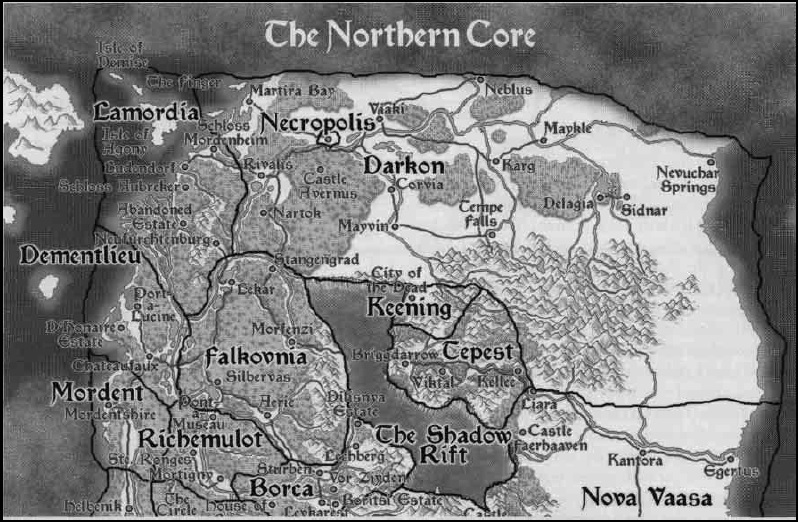
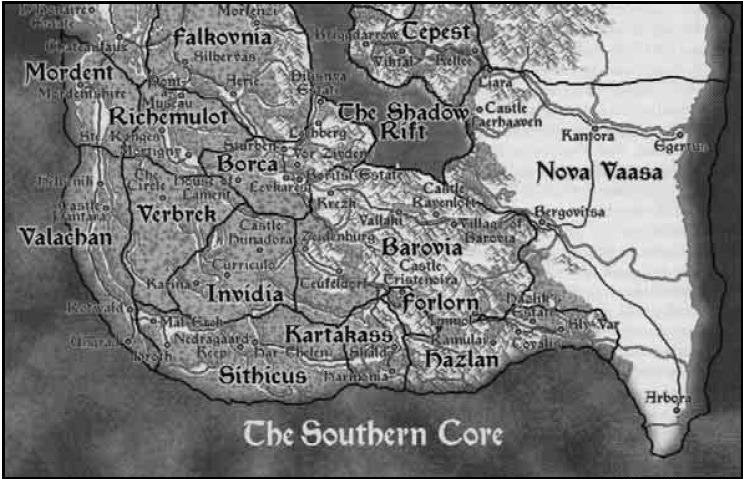
Darkon
Darkon is by far the largest realm in the Core, the most cosmopolite, the most diverse and the one with the most magic. It's the only realm to touch both seas. Boasting a population of 117 300, with a mere 75% human, it also includes 14% Halflings, 5% Gnomes and 3% Elves. Half-elves and Dwarves make up 1% of the population each. This is the basic D&D fantasy realm. It is ruled by the wizard-king Azalin Rex, recently returned after missing for 5 years. While the wizard-king prefers to study magic over politics, he has been moving to restore order after his return. Each major settlement is ruled by a Baron, who can freely name vassals, set local laws, control trade and appoint magistrates. Despite rarely appearing in public, the hand of Azalin is felt throughout the realm through his powerful secret police: the Kargat. Immune to Baronial law, they answer only to Azalin himself.
Dementlieu
Dementlieu is one of the most scientifically and culturally advanced realms in the Core (CL 9). Despite it's small size, it's a bustling trade hub, thanks to it's many ports and well-traveled highways. The population counts 13600 people (94% human, 3% halfling). Arcane magic is accepted as a fact of life, but is seen mere distractions and entertainment, not a respectable pursuit. The realm is ruled by a Lord-Governor elected by the nobility, who then selects his Council of Brilliance to advise him. The current Governor is Marcel Guignol. The aristocracy is powerful, but has a long-standing tradition of providing for the needy, leading to the creation and maintenance of a food and housing network for the poor. Literacy is also almost universal. Despite this, the lower classes still suffer from desperate poverty and unspeakable crime, while the nobility believe their generosity gives them the right to abuse the poor as they wish. The realm is basically not-19th Century France, for all you fans of Les Misérables and Fantomas.
Interesting note: the capital of Port-a-Lucine is home to Alanik Ray, the famous detective.
Next: More realms, as I cover them through short posts instead of big walls of text to keep myself going.
Post
Original SA postFor all that I make fun of the terrible D&D Gypsies, I wouldn't have bought the entire 3.x line if I didn't love the setting in some way. Speaking of which!

Falkovnia
Falkovnia isn't a very nice place. Aside from the dark woods filled with vicious predators and unspeakable horrors, the realm is suffering under the military dictatorship of the mercenary-king Vlad Drakov. Population 64300 (Humans 93%, Halflings 2%, Half-Elves 2%, Gnomes 1%, Elves 1%). The members of the population not part of the military live in filthy conditions, leading to a huge disease problem. They are branded at birth with the seal of the king, marking them as his property. The military rules every aspect of the realm with brutal efficiency. The non-humans have it even worse: they are considered subhuman and treated as chattel slave. The state even encourages "breeding out" the nonhuman taint, though children with only one human parent are also seized by the state. Aside from being a sadistic tyrant (rumor goes that he accompanies his evening meals with execution by impalement), he's also a would-be conqueror. He has attempted to conquer all of his neighboring kingdoms, and failed disastrously every time. This only enrage shim further.
Forlorn
Forlorn is an empty land from which humanity has been driven out. It's only population is 1900 Goblyns, although rumors persist of an ancient order of druids hiding in the forests. The Goblyns follow a loose clan system, using tartans to identify each other. Supposedly, creatures more terrifying than the Goblyns haunt the ruined castle above the Lake of Red Tears. SOmetimes, expeditions of lumberjacks and miners try to claim Forlorn's natural resources, but none ever returns.
Hazlan
Hazlan is a realm divided between two ethnicity: the Rashemani are the lower class, making up 99% of the population and horribly oppressed by the Mulan, the higher class. The population of 26100 is mostly human (Humans 92%, Halflings 4%, Gnomes 3%). Hazlan's ruler is Hazlik, who is totally not a red wizard of Thay from Forgotten Realms you guys. He has no official mandate, but had managed to cement his rule anyway. He has organized a council of Mulan governors to oversee the various regions of the realm. Despite the appearance of law, the country runs mostly through a byzantine system of boons and favors. The Rashemani are mostly locked out of this system. For the longest time arcane magic was banned, but Hazlik recently changed his mind and has now set up his own magical academy. The cult of the Lawgiver is especially powerful in the realm.
Invidia
A sparsely populated realm of a mere 6 900 people (99% human), made up of mixed heritage with no clear central ethnic group. Infamous for their passionate personalities, Invidians are known to be quick to anger and to hold grudges. The class system is extremely loose, leading to a growing merchant class. Under the previous ruler, Bakholis, most the villages were independent as the ruler cared more about protecting his hunting rights than ruling the realm. This has changed since Bakholis was assassinated by a witch and a new ruler, Malocchio Aderre, has risen. Malocchio is more brutal than his predecessor and has been more aggressive about ruling his realm. He has formed an army of mercenaries, including some troops lent by Vlad Drakov, through which he enforces his will. He also uses them to pursue his burning hatred for the VIstani, with his mercenaries having orders to kill any Vistani they can find on sight. He has even started sending his mercenaries into other realms, leading to friction with Borca over sovereignty and with Barovia over Count Strahd's protection of the Vistani living there.
Next: we reach the letter K.
Post
Original SA postHorrible Lurkbeast posted:
Oh I remember that one:
the darklord is a dhampir/ghost who switches form painfully at dusk and dawn.
he plays the bagpipes.
Correct!
Rand Brittain posted:
I can't believe how long it took me to realize that Hazlik was kicked out of Thay for being gay.
IIRC, it's stated outright in one book somewhere, but I might be wrong.

https://www.youtube.com/watch?v=QgaRd4d8hOY
Kartakass
Kartakass is a small country of dense forests inhabited by singing lumberjacks. With a small population of 4 500 (Humans 98%, Half-Elves 1%) mostly centered on a few villages of log cabins and lodges, the place isn't important in the grand scheme of things. Singing and performance is super important to the people, to the point where each town's governor is elected through a singing contest. These Meistersingers are the closest thing to a government Kartakass has. Bards are well regarded and given warm receptions, and there's a tradition of tall tales mean to teach lessons and play on the gullibility of listeners. The Kartakans are overall pretty happy, though they do live in fear of the country's vicious wolves. There are legends that tell of times when wolves took on human shapes to trick people...
Keening
Another empty realm with no living inhabitants, Keening is dominated by Mount Lament, a windy peak crowned with fog. The only settlement in a ruined village inhabited by 970 mindless undead, who shuffle through a mindless parody of their mortal lives. Sometimes brigand and dwarves venture into the domain to seek the mineral wealth of the mountain or other plunder. The wind from the mountain often sounds like a mournful song.
Lamordia
A cold country in the north of the continent, Lamordia is also another advanced civilization (CL9). With a laughably small population too (3 200, 99% human). Lamordians are a hardy folk, and the least superstitious in the world. No church holds sway there, and they mostly trust in rationality and common sense. They distrust anyone who promise easy solutions with magic. Mayors are elected by a council of wealthy aristocrats, who are themselves elected by all male landowners. The ruler is Baron von Aubrecker, who prefers to hold court in his estate than rule. Despite the weak government, most Lamordians manage to get through with minimum conflict and crime. The harshness of the land makes travel difficult, leading to the realm being fairly isolated from the rest of the Core. It is said a demonic creature lives on the frozen Isle of Agony. Most people hold the infamous Doctor Victor Mordenheim, a shady surgeon and scientist, in contempt as he continues his strange experiments in his northern estate.
Markovia
Markovia is a tropical island inexplicably situated in the cold northern Sea of Sorrow. The canopy is so dense that the vine-covered forest floor is always shrouded in shadows. The shore is dotted with ancient basalt statues with their heads and arms upraised to the sky. Some sailors have seen structures on the island, including a stone monastery on the southern cliffs. There are many sightings of "beastmen", animal-like creatures that walk on two legs and use crude tools and weapons. Many domains have attempted to colonize the island, and all have failed so far.
Post
Original SA post
Mordent
This is another of the high-tech Renaissance Domains. Mordent is a land of foggy moors, plains and swamps. It's full of empty manors and haunted ruins. The most infamous is The House on Gryphon Hill, where the ghost of Lord Wilfred Godefroy resides. Most of the population (a whopping 5 500! 99% human) lives along the coast. The Mordentish are simple, practical people who value tradition and are highly superstitious. They avoid the many haunted places that dot the land religiously. The ruler is the aging Lord Jules Weathermay, his family being the last survivor of the many noble houses that once lived there. His son-in-law, widower Daniel Foxgrove, is the mayor is the only major town, Mordentshire. His son George Weathermay wanders the Core hunting monsters and fighting evil, while his grand-daughters the Weathermay-Foxgrove twins (Gennifer and Laurie) seem to want to follow in Van Richten's footsteps. Mordent was where Van Richten lived before his disappearance, and the twins have taken over his old workshop and re-started printing his old monster Guides.
Necropolis
This used to be Il Aluk, the greatest city in Darkon. Except Azalin blew it up during his latest scheme. Every living person in the city was instantly killed and raised as undead. Anyone who enters the city instantly dies and becomes undead too. The dead have organized into a strange complex society, divided into strange sects and factions. The 26 800 dead who make the city their home revere their leader, a strange and powerful being known only as Death.
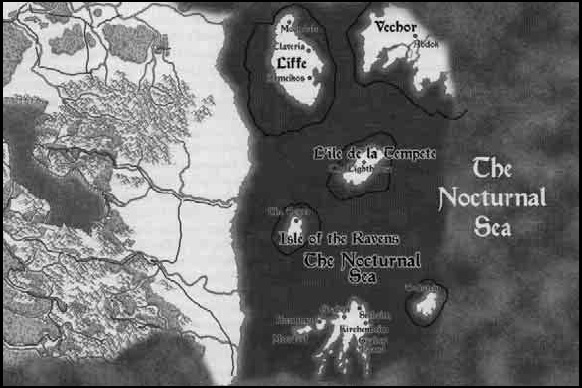
The Nocturnal Sea
The Nocturnal Sea is dangerous, the weather is violent and erratic and the water is full of shoals. The gray sky, constantly overcast, makes navigation difficult. The Nocturnal Sea is dotted with islands, though many of these are tiny and uninhabited. Known islands include Liffe, a rustic isle of farmers and musicians; sober Graben and Knammen; L'ile de la Tempete with its mysterious lighthouse; the ominous Isle of the Ravens; and frigid, forsaken Todstein. The population is once again laughably small. Liffe is ruled by Baron Evensong, a bard who prizes his island's independence. Graben and Knammen are ruled by the Grabens, a wealthy merchant family. The rulers of the other islands are shrouded in mystery.
Nova Vaasa
A large, flat country full of farmlands and ranches used to feed the overpopulated cities (some have as many as 16 000 inhabitants!). The "cities" are described as nightmares of dreadful urban squalor. The streets are filled with beggars and the ditches are full of plague-bloated corpses. The class divide is strong here. Five aristocratic families rule the realm: the Bolshniks, Chekivs, Hiregaards, Rivtoffs, and Vistins. The tiny aristocracy is extremely wealthy while the poor are hungry. Vice and crime are rampant. The realm is dominated by the church of the Lawgiver, which means rebellion is rare. The current ruler is Othmar Bolshnik, a vain and ruthless tyrant. Tradition dictates that rule switch from one noble family to the next every five year,s but Othmar has held onto for twenty-five years now. His only rival for power is the mysterious crime lord known as Malken. This shadowy figure controls all that happens in the underworld of the country, In the dark alleys, his words his law and not Othmar's. Malken has become a bogeyman to the poor of Nova Vaasa.
Post
Original SA postSpeaking of racist depictions of Roma, more Ravenloft.

RIchemulot
The land of Richemulot is mostly empty, as the population is found mostly in the three major settlements of the realm. The cities are huge, and could easily support three times their population. Not even the Richemuloise know what happened to those who originally built these cities and abandoned them. Underneath are large modern sewer networks, twisting deep into the earth. The realm is ruled by an aristocratic nobility who have absolute control over the domain, but there is a surprising amount of class mobility. Knowledge and secrets are highly prized and a noble can easily fall by having his secrets revealed while a simple cobbler can become a noble overnight by overhearing the right secret and using it wisely. This makes Richemuloise intrigue particularly dizzying in their complexity. Thanks to the overall economic well-being of the nation, though, there is a large number of immigrants. Jacqueline Renier, matriach of the Renier family and unofficial ruler of the Domain, welcomes anyone as long as they have a weapon and swear fealty to Richemulot itself. Jacqueline is a very ruthless and cunning ruler, but also fiercely patriotic. She is well regarded by her subjects.
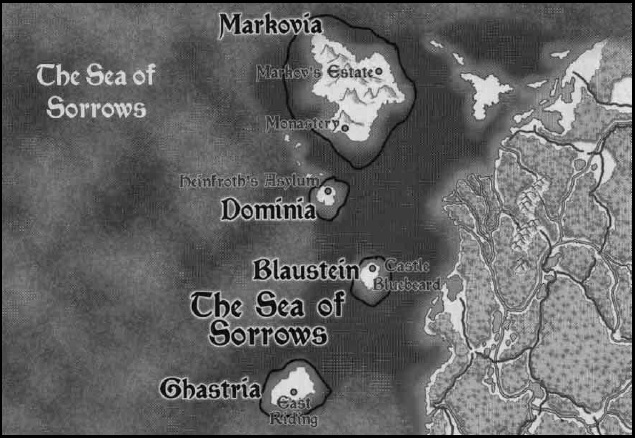
The Sea of Sorrows
The western sea is cold and foggy, with few storms but unpredictable winds. The sea has something of a haunted reputation; tales of ghost ships, particularly the legendary Relentless, are not uncommon among veteran sailors. There are few islands in the Sea: Ghastria is a pastoral land inhabited by farmers and ruled by the Marquis Stezan d'Polarno. The Marquis throws annual galas for nobles who make the journey to the Island. Blaustein is a rocky place inhabited by thugs and ruffians, fiercely loyal to their secretive tyrant Bluebeard. Dominia'S only settlement is the asylum of Daclaud Heinfroth, a renowned institution for treating those plagued by madness.
The Shadow Rift
The Shadow Rift is a vast hole in the middle of the core. No bottom can be seen, as dark swirling vapors appear after a certain depths. Few, if any, return from those vapors. Stories abound about the monsters that supposedly come up from the Rift, and most speculate it is a gate to a terrifying and alien world.
Sithicus
This is perhaps the only domain in the Mists to be primarily non-human. There's a missed opportunity there for dark Dwarf and Gnome kingdoms, if you ask me. The Domain is one of ancient foresta and fading glory, as the elves seems to apathetic to care that their houses are rotting away and their libraries are being overrun by mildew. The country was originally ruled by a mysterious Dark Knight from Nedragaard keep,
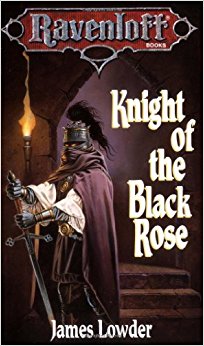
This guy
but ever since his disappearance a dwarf named Azrael has claimed the throne. Azrael is cruel and is hated by the elves, but they fear him more. He controls undead troops, and some whisper he has supernatural powers of his own. Despite the isolationist nature of Sithicus' High Elves (and their racism), a growing number of marriages with visiting merchants has created a new minority of half-elves in the realm.
Post
Original SA postToday, I finish the Domains of the Core.

Tepest
Tepest is another realm fo creepy forests with names like Goblinwood or Wytchwood. The population live sin tiny hamlets and small keeps held by the nobility. They are very superstitious, especially about "little beasties" from the forests and the fey. There isn't much of an organization in the realm, most villages being ruled by elders who appoint magistrates and warriors. In recent years, the Church of Belenus has become very powerful and launched a crusade against the fey, armed with sword and fire. This has led to much denunciation of evildoers in league with the fey being judged by hastily-assembled tribunals and killed. This witch-hunt is led Wyan of Viktal, a severe man who takes drastic measure when purging a settlement of evil.
Valachan
Valachan is a wet land of ancient redwoods and small villages. The wilderness is full of vicious and cunning panthers, highly feared and respected by the Valachani. The Valachani themselves are a friendly and welcoming lot, proud of their hospitality. They value physical skills and are wary of book learning. This might be somewhat unfortunate as they are also described as majorly dark-skinned, but the book barely mentions their skin-color and makes no big deal out of it so who knows. Baron Ulrich von Karkov rules from Castle Pantara, using a band of highly trained zealouts who are as sadistic as their master. Lady Adelaide, their leader, is well-known for her viciousness. She can be bribed by the gift of an handsome youth, who usually emerges scarred inside and outside from her clutches. The Baron will often ask for service from random commoners, summoning them to Castle Pantara for one night. Those who go often return with the White Fever, a mild but debilitating flu. He also often takes young women as wives, none of which live for more than a year afterward.
Vechor
A strange land on the other side of the Nocturnal Sea, Vechor reflects the mind of it's ruler, the wizard-tyrant Easan the Mad. The land constantly shifts, roads change direction overnight, villages rearrange themselves, and even the sky itself will change color to purple or green when it feels like it. The people of the land have learned to live with these constant shifts, recognizing the moods of their lord in them. Their loyalty to Easan and belief in his godhood is unquestioned. They voluntarily brand a red E in their forehead as a show of loyalty. There are almost no taboo or social classes in Vechor, although marriage is held as sacred. Widower and widows do not remarry and unfaithfulness sis punished by death. There are no official militia or magistrates: mob rule deals with crime, and lynchings are common. As for Easan, he is never seen in his realm. His opulent castle in Abdok stand empty. It is rumored that the king spends most of his time in a mystical dwelling beyond the Cliffs of Vesanis, cackling madly and listening to the whispers of ancient evils.
Verbrek
Verbrek is a land ruled by wolves, where humans are hunted as prey. The Verbrekers live in isolated settlements, protected by huge moats. Nature is not friendly there, and mwhen going through the realm's irregular trails (there are no large roads), one always feels watched. The Werewolves who truly rule the land seem to toy with humans instead of simply slaughtering them all, taking their victims one at a time when they feel like it. They seem to worship a mysterious Wolf God, an avatar of savagery and cruelty. Only a few river merchants travel through Verbrek, in search of timber, furs and other commodities.Regardless of the season, travelers may encounter the gregarious Captain Nathan Timothy navigating Verbrek's rivers. The captain is willing to transport passengers aboard his cargo vessel, the Virago, for a reasonable fee.
Next: Out of the Core, we learn of the smaller Clusters in the Mists.
Post
Original SA postI've had an annoying headache all day, but I somehow managed to write a small Ravenloft post.

Outside of the Core, there are many smaller Clusters, usually of 2 or 3 Domains only. They can be reached through the various Mistways, or randomly whenever the Mists (aka the GM) feels like it.
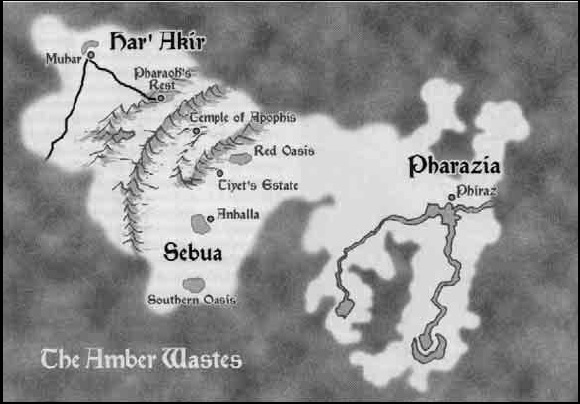
The first Cluster we look at is The Amber Wastes, the desert one. There no seasons here, and the few who live there do so around oasis or wells.
Har'Akir
Har'Akir is an empty wasteland where once there was a thriving empire. Monuments and ruins are scatterred across the desert, and great tombs where ancient pharaohs sleep. The greatest is the tomb of Pharaoh Ankhtepot, legendary for his cruelty. Only one oasis exists in Har'Akir, near the small village of Mubar. The villagers take great pains to control this precious resource. Clerics rule over the small population, a pale shadow of the organization that once advised Pharaohs. The high priestess of Osiris, Snefu, is a stern woman with decadent tastes. Slavery is accepted in Har'Akir, and almost a third of the population are slaves. For the longest time the Domain was isolated, but tales of the buried treasures have recently reached the Core and many foolish adventurers could come and try to plunder the land.
Pharazia
Pharazia is a land of endless deserts, with a few rare oasis and muddy rivers helping the population survive. In the heart of the Domain is the city of Phiraz, the jewel of the desert. A large city with streets filled with many vendors, the inhabitants are nonetheless fearful. They are ruled by Diamabel, an angelic creature with feathered wings who demands perfect obedience to his edicts. Supposedly a celestial agent sent to teach the right word, though, and deed to humanity, no one knows where Diamabel really comes from or what God, if any, he follows. Confessors, wearing white and wielding scourges, patrol the streets accompanied by warrior zealots. At night, the mysterious Black Herald, said to be the embodiment of Diamabel's vengeance, slays the worst transgressors. In the desert, nomads who refuse to bow down to Diamabel have united under the leadership of Sheikh Allahn el Rashaan, a cunning warrior who leads thanks to his charisma, wealth and battle prowess.
Sebua
Between Pharazia and Har'Akir stands Sebua and the Valley of Death. The Valley is full of empty tombs and ruined temples to ancient gods. The Red Oasis swarms with mosquitoes. Black storm clouds gather over the valley and burst into torrential rain late at night. The city of Anhalla stands ruiend by time and the desert. Angry baboons occupy the city, as well as mysterious wild children. Speaking only their own unique wildspeak, these savage children fight and survive in this harsh land. Strangely, no one knows where they come from or why no one has seen them age after years. On the outskirts of Anhalla, a magnificent walled estate still stands untouched by the slow death that is gradually claiming the city. Travelers have reported hearing sweet music and laughter floating over the walls, but none has ever glimpsed the festivities within and returned. Outsiders rarely venture into Sebua, despite the resources such as water, food and minerals that can be found within, or the treasures that could be found in the Valley of Death. They are many monsters supposedly haunting the dunes of Sebua, such as the Scabrous One.
Next: We got from hot to cold.
Post
Original SA postLet's keep this going.

We now reach the Frozen Reaches, a cold Cluster that knows eternal winter.
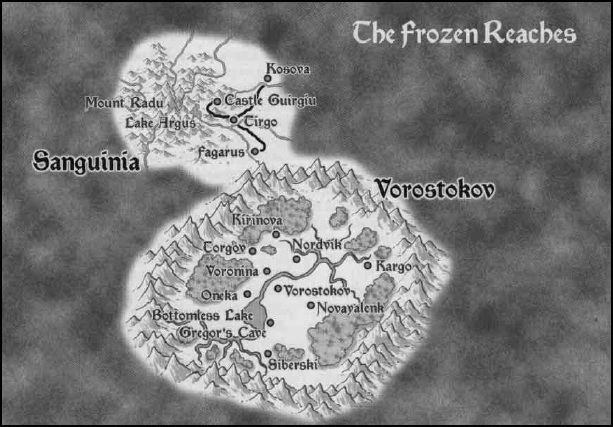
Sanguinia
Sanguinia is a harsh mountainous land, dominated by Mount Radu. The population lives in small huts barricaded against the cold, somehow managing to survive in a terrible climate. The ruler is prince Ladislav Mircea, who resides in his grand castle Guirgiu. The Prince is cruel, but demands little from his people. His enforcers, clad in ashen clothes and wielding battle axes, come to collect taxes but otherwise stay near the castle. The Prince is supposedly beautiful, but he is rarely seen by the villager,s who dare not go to the castle. The land is also marked by mysterious menhirs, left by some vanished tribe no one remembers.
Vorostokov
Vorostokov is a vast, frozen valley terrorized by brutal warriors. Formerly independent, the various villages are becoming united by force. Now that the eternal winter has fallen, Gregor Zolnik has proclaimed himself boyar of the valley and recruited a loyal band of warriors, enforcers and thugs. Those who dare rebel against his rule are brutally dealt with: Gregor has all the hunters and trappers of a rebel village killed, condemning it to starvation. Gregor then offers the game caught by own hunters as the price of fealty. This way, Zolnik's reach is slowly extending toward the entire valley.
This was short, let's do another Cluster.

The Shadowlands are named after Shadowborn family, whose destiny seems intertwined with the region. Who are the Shadowborn? Not explained in the book, and since the Gazetteers never reached outside the Core, you're out of luck if you want info on this. Even Legacies of Blood, the book giving rules on playing members of important families, got jack shit on the Shadowborn. You have to go deep into obscure AD&D supplements or Dragon articles to find some info, or even *shudder* read some of the licensed novels.
Avonleigh
Avonleigh is an empty, haunted forest. There is a remnant of a King's highway going through, still somewhat intact. Other leftovers hint at when the Domain was inhabited. The only major landmark is Tergeron manor, a sprawling estate claimed by the forest. The belfry is illuminated by a strange light, leading to speculation of living people inside the Manor.
Nidala
Nidala is a relatively prosperous domain being strangled by it's Knight-Protector, Elena Faith-hold. She rules her realm through respect, order and fear. Her castle, the Faith-Hold, is constantly subject to a raging thunderstorm. Elena issues weekly decrees of faith, commandments and prohibitions that have accumulated into a mountain crushing the inhabitants. Through her knights, clerics and informants, Elena severely punishes anyone who breaks her decrees. This includes visitors, even if they have no way to know the law, leading many to find themselves in her torture dungeon within days of arrival. What stops the people from revolting, however, is the terrifying dragon Banemaw. Elena's presence alone is what keeps the monster at bay.
Shadowborn Manor
Somewhere, deep within the Phantasmal Forest of Avonleigh, lies Shadowborn Manor, the ancient lost home of the Shadowborn family. Some say the manor is haunted by the restless spirit of Shadowborn knights, while others say it is an enemy of the Shadowborn family that now holds sway over the Manor.
Next: Not-India and Not-London
Post
Original SA post
I promised Not-India and Not-London, and here they are.
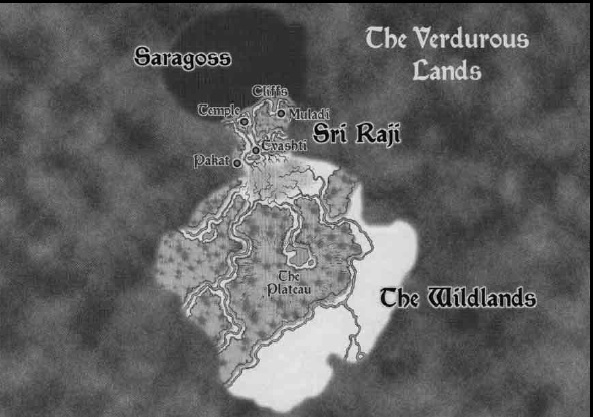
The Verdurous Lands are hot, humid and posses dense vegetation. There's only a dry and a rainy season.
Saragoss
Saragoss is a large ship graveyard, covered with a never-ending fog hiding the treacherous seaweed that grasps any passing ship and never lets go. The few inhabitants are all sailors stuck there, fighting each other to survive in a brutal environment where resources are few and limited. Sharks and monsters also haunt the sea: from ghost buccaneers to scaly fishman will appear to attack the hapless sailors. Few escape, as they cannot know that just beyond the fog to the south lies land.
Sri Raji
The cities of Sri Raji are walled bastion of civilizations surrounded by vast rice fields. Outside of these areas, dense jungle and ancient ruins can be found. The ruler is the dread Maharaja Arijani, who lives in the Accursed City of Bahru, inside his palace Mahakala. He is actually the high priest of Kali, but no one opposes his self-promotion to Maharaja. Despite his cleric spies being everywhere, all Arijani asks from his people is a single sacrifice to Kali each day. The poor chosen is sent to Bahru on an albino elephant, never to return. The cities have some amazingly beautiful architecture, contrasted with abject poverty in the streets. The caste system that rules the Domain is absolute. The Sri Rajians take tradition and religion very seriously, with a large number of gods and a complex theology based on cosmic cycles. The University of Tvashti is world-renowned, as the wisest scholars study all facets of technology and the natural world within it's halls and libraries. Despite this, Sri Raji is merely CR4 (Classical).

The Wildlands
South of Sri Raji are the Wildlands, a land of beasts where man is not welcome. It's a large land, teeming with all kinds of wildlife both natural and supernatural. Any attempts at settlement have been ruthlessly crushed. Some do still adventure into the land, in search of emeralds or gold or even the legendary elephant's graveyard said to exist within the Wildlands. Strangely, it seems as if no snakes exists within this Domain.
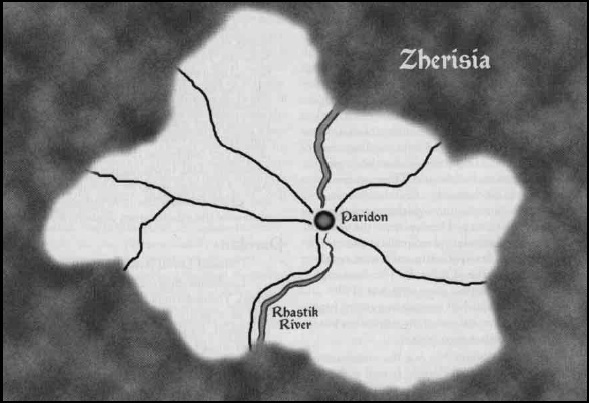
The most useful map
Zherisia was the name for the Domain that once existed outside of Paridon, and though the land is now unknown the inhabitants of the city have kept calling it that way.
Paridon
Paridon is a bleak city, steeped in fog and bloodshed. Everyone tries to be home before nightfall, to escape from the brigands and scarier things that come out. With the disappearance of the Domain that once fed the city, they have transformed their once-beautiful parks into meager crops. They also import a lot fo foodstuff from other Domains, but hunger remains a problem for the lower classes. Religion isn't common, although the "theological philosophy" of the Divinity of Mankind is popular. This cult preaches perfection of the mind, body and spirit. The city is ruled by a council of aristocrats, who care little for the needs of the lower classes, but is surprisingly progressive in other ways. The press is not controlled by the aristocracy, and the law applies equally to all. Every 13 year, the city's most infamous inhabitant strikes: the still uncaught Bloody Jack. The killer is due to begin his rampage again this year.
Timor
Some scholars have recently noticed that the sewers of Paridon no longer fits with the existing maps. It's because they are now the Domain of Timor: an endless maze of brick tunnels, always leading further down, filled with filth, poison and monsters. Those who get lost down there rarely come up again. The inhabitants of this Domain, if any, are unknown but most likely not human.
Next: After the smaller Clusters, we now reach the Islands of Terrors, all alone in the Mists.
Post
Original SA postIt's been a week without updates on the land of Mists, and I'm (finally!) starting my internship tomorrow, so here's a big dump for the road.

Islands of Terror a single Domains, all alone in the Mists, with no clear borders. They are lonely and frightening places, with limited contact with the outside world.
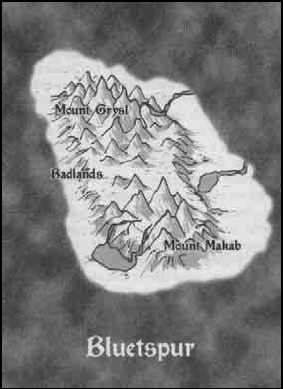
Bluetspur
This is a land of rocks and dirt with nothing in it. There are no plants or animals, no wind, no weather. The sky is dark and starless, while a red glow near the horizon is the only indication of night and day as it fades and then returns in 12-hour cycles. At night, red lightning can be seen in the distance. A strange hum can be heard coming from deep underground. No travelers come willingly to Bluetspur, and those who do run away as soon as they can.
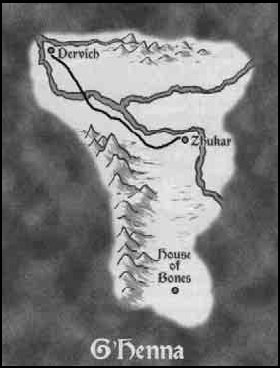
G'Henna
This Domain is a bleak wasteland where hunger is omnipresent. It is a theocracy led by the brutal cult of Zhakata the Destroyer. The high-priest, Yago Petrovna, is a zealot who often drives himself into religious fervor as he speak to the people. The Church controls everything, and the secret Inquisition help Petrovna keep control of the population. Every day, all the food produced is given to Zhakata, and whatever is left at the end of the day is what the people will have to subsist on. The only opposition the Church has is a group of fiercely atheistic bandits that lead a guerilla campaign, led by a mysterious man known only as the Jackal.
Odiare
There isn't a map for Odiare, as it is a small village of only about a 100 inhabitants. This is the "evil pinocchio" Domain someone mentioned earlier. All the adults were killed 20 years ago by Maligno, a terrifying wooden puppet, and his army of toys. The current villagers are approaching thirty and some even have children of their own, but they remain terrified of Maligno and are afraid he would hurt anyone he sees as a threat towards the children. Giuseppe, Maligno's creator, was spared and remains in his workshop working on who knows what.
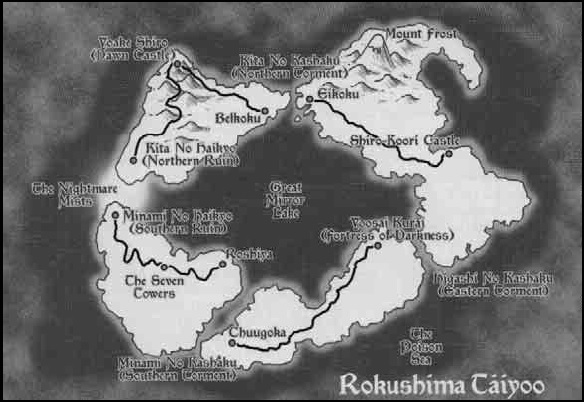
Rokushima Taiyoo
Supposedly this means the Six Islands of the Sun, but I feel it's not quite an appropriate japanese sentence, although it's still better than most Legend of the Five Rings names. Now there are only four islands, but supposedly there were two more before: the islands sank when their lords, the shujin, died. The four remaining shujin keep warring with each other dreaming of supremacy, while ignoring this particularly ominous omen. Ninja clans are mentioned as being involved on various sides of this conflict. The Domain was isolated for the longest time, surrounded as it is by a poison sea, but recently Dementlieuse and Mordentish ships have appeared. While the people don't care about these strangers, the lords are alreayd thinking of how they can use these newcomers and their weapons to their benefits.
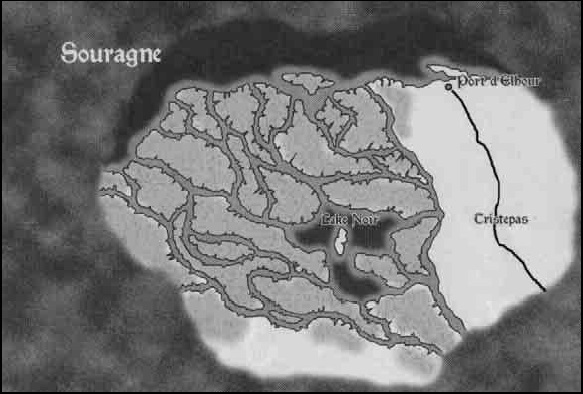
Souragne
A large swampy bayou called "Maison d'Sablet" dominates most of the Domain. The rest is plantations of sugar and cotton, overseen by a brutal aristocracy. The proprietors are the nobles, and everyone else the commoners, who are often treated quite horribly by the landlords. Worked to death, beaten, etc. The Souragniens believe in the Loa, the most feared being the Lord of the Dead, who can animate the dead as zombies. In deference to him, all corpse are left for four days before being interred, so that he may claim those he wants. All arcane magic save Necromancy is banned. The aristocrats encourage trade with other realms, dreaming of their port becoming a rich trade hub, but despite the sugar canes and cotton few outsider merchants like travelling to this strange and cruel land.
And that's it for all the Domains. In summary, Ravenloft is a land of contrasts.
Next: Back to D20 rules. Joy.